

| This area shows aviation at its finest, from supersonic military jet fighters and commerical aircraft to civilian aerobatics and skydiving! I have decided to put together this section to illustrate the beauty and excitement of various airshow displays I have experienced. Be sure to check out the Golden Knights skydiving team pictures, as well as some precision flying by our US Navy's Blue Angels and Air Force Thunderbirds! Keep in mind that this area is separate from the "FLYING" and "SKYDIVING" section of this site because it is a journalistic approach to the "spectators" view of such events. Note - This page may take a while to load on some SLOWER connections! |
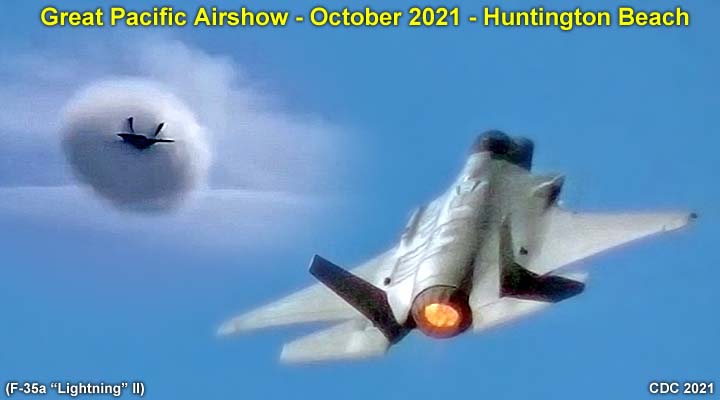
The Great Pacific Airshow was in Huntington Beach, California on October 2 and 3, 2021 after it was canceled in 2020 (due to the Covid-19 Pandemic). The 2021 airshow was fantastic, featuring BOTH the USAF "Thunderbirds" and US Navy "Blue Angels". In the image(s) above, an F-35 "Lightning" II can be seen in full afterburner and approaching the sound barrier, creating a vapor "shock" cone. This is one of many awesome displays of aviation and air power on this web site!
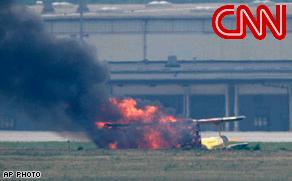
Another sad event in the airshow circuit. Jim Leroy was killed in an accident at the airshow in Dayton, Ohio on July 27, 2007. The proficient aerobatic pilot was just completing a loop meneuver when the Pitts Special struck the ground, slid about 300 yards, and burst into flames. Leroy was extricated from the destroyed aircraft by emergency personnel and airlifted to nearby Miami Valley Hospital, where he died from his injuries en-route. There are MANY performances that were done by Jim Leroy, many of which appear with his "Bulldog" sponsored bi-plane in this section (see below). This tragic event was also accompanied by another un-related fatal accident in Oskosh, Wisconsin. This weekend was not a happy weekend in the sport aviation arena. Jim Leroy will be missed by many airshow fans, family, and friends.

The FORT LAUDERDALE AIR AND SEA SHOW is a yearly event in South Florida since 1995. Each year, usually during the first weekend in May, a collaberation of aircraft and boats puts on a show with a theme as a "salute to the US military" with the Fort Lauderdale beach front as a setting. In the two day event, literally millions of people visit with as many as a million people on the beach at a given time during the air and sea show hightlights! This event features both a full-fledged airshow, with civialian and military aircraft as well as a "sea show" featuring boats and water sports demonstration. The event is funded by sponsorship (formerly Shell now Mc Donalds), taxpayers for the military displays, and the city of Fort Lauderdale. The picture above is a wide angle shot of the crowd-packed beach during one of these air and sea shows in May 2004. In the latter years following 2007, this event was cancelled, suffering major government cuts and expenses. It did make somewhat of a comeback in 2012 but was quickly snuffed to civilian only performers following the 2013 sequester and US Federal cuts.
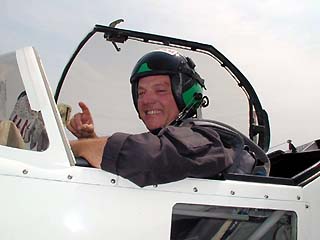
Ian Groom, pictured above (picture courtesy of IAC), was tragically killed while practicing aerobatic routines prior to the Fort Lauderdale Air and Sea Show on the afternoon of Friday, April 30, 2004. Loss of this great aerobatic pilot will be missed by many fellow pilots and fans as well. He was apparently in a flat-spin meneuver, very popular for aerobatic pilots, from about 3,000 feet in a Russian SU-31. For some un-avoidable reason, the aircraft was unable to recover from the spin and struck the ocean. Blunt trauma (impact force) and subsequent drowning were the cause of death according to paramedics. This was the first fatal air accident in the 10 years of this yearly south Florida event and is very disturbing.
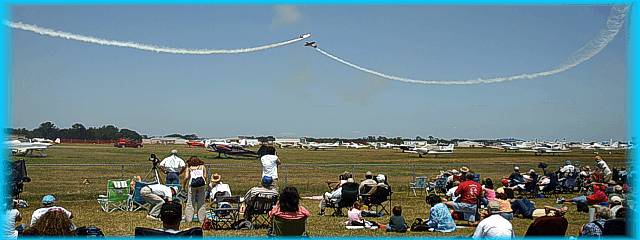
The "Sun 'N Fun" fly-in is a week long airshow and exhibition event held in Lakeland, Florida each year. This event is not like any "average" airshow, but a full convention including hands-on workshops, vendors, unusual aircraft, static and flight-line displays, and ofcourse, an airshow. Pictures for this event have been added to the "STATIC DISPLAY" section of this site as well as all the other sections. If you love aviation and planes as well as the people who fly them, whether or not you are a pilot, then this is the place for you. Everything from demonstrations and hard-to-find aircraft parts to aerobatic rides can be found here. Only Oskosh in Wisconsin has a larger such yearly convention. You can also check out their official web site by clicking the link HERE!
 Great Pacific Airshow (Huntington Beach) In October 2019 / 2021
Great Pacific Airshow (Huntington Beach) In October 2019 / 2021 Fort Lauderdale Airshow In April 2013 Video
Fort Lauderdale Airshow In April 2013 Video Air And Sea Show "Blue Angels" Video
Air And Sea Show "Blue Angels" Video C-130 Jet Assisted (JATO) Take-Off In 1994 Video
C-130 Jet Assisted (JATO) Take-Off In 1994 Video
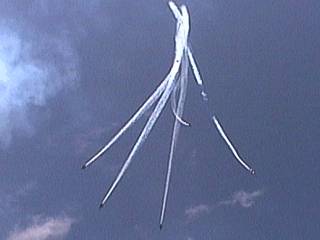
|
The US Navy Blue Angels demonstrate the "bomb-burst" meneuver at the Fort Lauderdale Air and Sea Show at Fort Lauderdale Beach, Florida in May 2002. This picture shows the meneuver, where 5 jets dive straight down and pull up while spreading out in opposite directions. The sixth jet then comes upwards and right into the smoke trails left be the first 5 going down. |
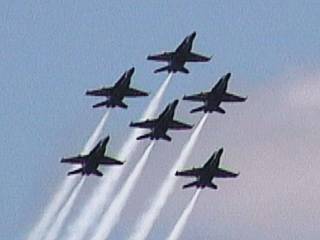
|
The US Navy Blue Angels fly over show-center in the beautiful "delta-diamond" formation at the Fort Lauderdale Air and Sea Show at Fort Lauderdale Beach, Florida in May 2002. With smoke on, all six F18 aircraft fly in formation with the diamond portion in the front and two trailing "slot" planes in the back. |
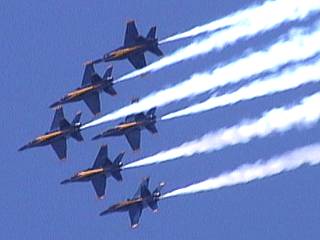
|
The US Navy Blue Angels fly in full six-plane "Delta" formation over the Fort Lauderdale Air and Sea Show at Fort Lauderdale Beach, Florida in May 2002. The planes transition to the diamond, with wing tips at close as 18-inches, and roll an entire 360 degrees as the crowd cheers them on. The precision of the flying makes it almost as if the six planes are "connected" as one single large one! |
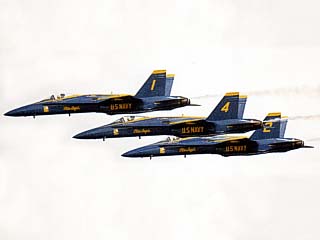
|
Three F18 "Hornets" fly by show center during the Fort Lauderdale Air and Sea Show for the US Navy Blue Angels demonstration in May 2004. The planes here are only about two feet apart and flying at over 450 MPH. Can you see the pilots heads? |
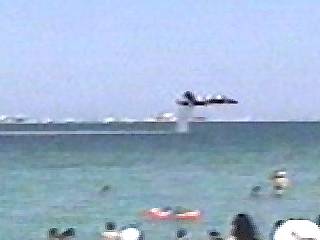
|
During the US Navy Blue Angels demonstration at the Fort Lauderdale Air and Sea Show at Fort Lauderdale Beach, Florida in May 1998, one FA-18 "Hornet" makes a low pass at nearly 750 MPH (near the speed of sound) to startle the crowd. In this picture, the jet creates a visible shock-wave that envelopes part of the airplane and leaves a white trail of spray in the sea surface from the violent shock wave. You cannot hear the airplane until after it has passed with a loud bang or "boom". The aircraft here cannot fly any faster because the shock waves will break windows in Fort Lauderdale, so the pilot just nudges his airspeed to just under MACH 1.0 to create a small shock wave (that will dissapate farther from the plane) to "wow" the spectators. Very cool to see, and hard to get on video! |
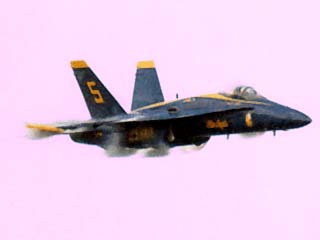
|
Here is a much better and closer still photo of the famous "transonic pass" of an F18 during the US Navy Blue Angels demonstration at the Fort Lauderdale Air and Sea Show at Fort Lauderdale Beach, Florida in May 2004. In this case, slightly drier air conditions limit a plane-shrouding mach stem to form, but if you look closely you can see the shock-waves (caused by the mach stem) around the leading edges of the aircraft. This is also known as the Prandtl-Glauert singularity. |
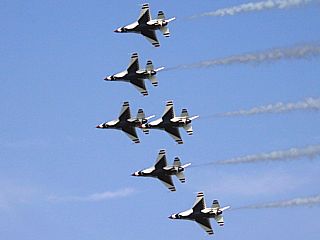
|
The United States Air Force Thunderbirds is an elite demonstration team comprised of six F-16 "Falcon" jet fighters. In this picture, taken at the Fort Lauderdale Air and Sea Show in May 2007, six F-16's fly in tight delta formation trailing smoke in a pass in front of the crowd. |
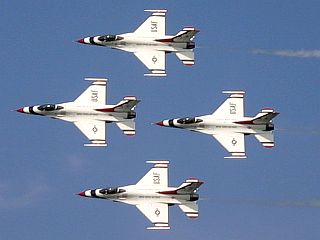
|
Here is another close-up picture of four of the F-16's of the USAF Thunderbirds doing a diamond formation pass in front of the crowd at the Fort Lauderdale Air and Sea Show in May 2007. |
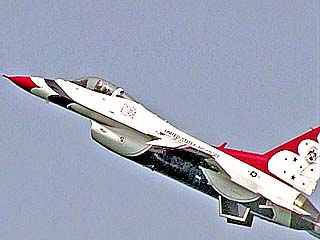
|
Close-up of one of the F-16's with the United States Air Force Thunderbirds doing a slow "high-alpha" pass (high angle of attack) at the 2018 Chicago Air and Water show. Note the cockpit and pilot (with oxygen mask), as well as the fixed geometry of the jet intake of the F16. |
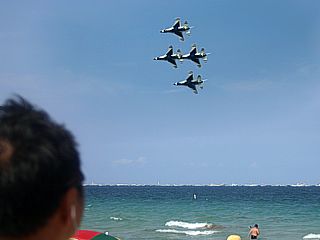
|
The diamond formation of the four F-16's passes the crowd and enters a high-G turn about a hundred feet or so above the sea surface. The other two fighters, called "solos", are on their own and doing their own meneuvers while these 4 fly in formation. |
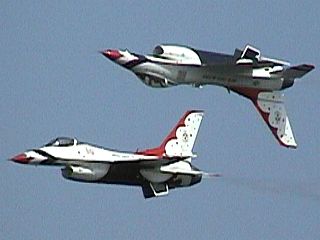
|
Aside from the four F-16's in the formation, the other 2 F-16's of the USAF Thunderbirds have some more crowd pleasing tricks for the 2007 Fort Lauderdale Air and Sea Show. Here the two "solo" planes do a "calypso pass", where one is inverted (upside down) above the other in a high-speed pass (about 500 MPH). |
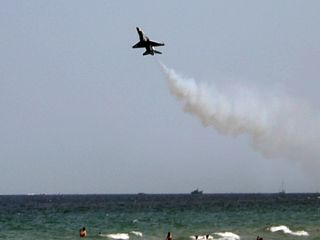
|
Here is an F-16 USAF Thunderbird doing a slow pass (about 110 Knots or so) at the Fort Lauderdale Air and Sea Show in May 2007. The engine is producing thrust, which is precisely controlled by the aircraft's flight computer (fly-by-wire system) along with the aircraft's control surfaces, allows the plane to pitch up at a very high angle of attack and fly very slowly. |
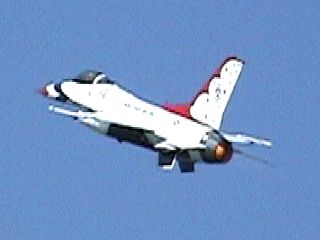
|
After completing the low and slow pass, the F-16 USAF Thunderbird selects full afterburner and powers his way skyward, making the ground shake and air shatter with the thunderous roar of the afterburner jet. The F-16 plane produces more thrust than its weight, therefore it can accelerate going straight up. |
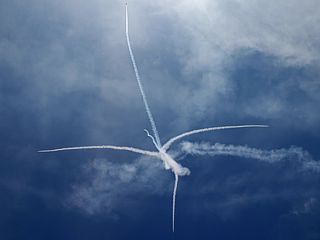
|
This is one of the spectacular and signature demonstrations for the USAF Thunderbirds. This is called a "bomb burst". Four of the F-16's in the diamond formation pull into a vertical zoom climb and put on the smoke once in a vertical attitude. Each executes an immelman, so at the top of the "burst", all 4 F16's are headed away from each other. A 5th plane, then pulls vertically through the middle of the smoke trails with aileron rolls with its smoke trail leaving an intersting "cork-screw" effect. The first 4 planes then come back around and converge at a point right under the "bomb burst" and pass within feet of one another. This was a definite cloud pleaser for all at the 2007 Fort Lauderdale Air and Sea Show. |
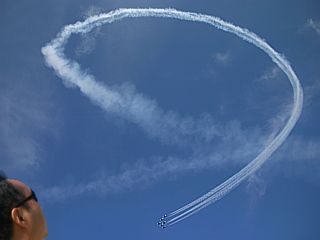
|
All F-16's USAF Thunderbirds perform a large loop meneuver while in diamond formation at the 2007 Fort Lauderdale Air and Sea Show. The loop here, carved into the sky by the smoke trails of the planes, is about 10,000 feet high. This is roughly 100 times the size of a large loop on a roller coaster! |
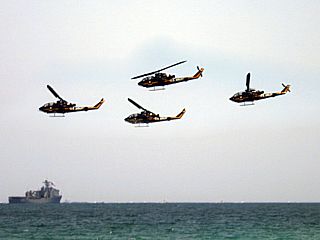
|
Here is the United States Army "Sky Soldiers" Cobra Helo Team at the 2007 Fort Lauderdale Air and Sea Show. What is so interesting about this team is that they perform formation flying, even aerobatics, using four AH-1 "Cobra" attack helicopters instead of airplanes, complete with smoke generators and all. |
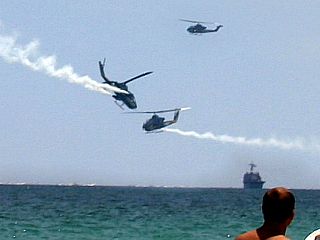
|
Two opposing solos of the United States Army "Sky Soldiers" Cobra Helo Team perform a cross-over at the Fort Lauderdale Air and Sea Show in 2007. With smoke on, the two AH-1 "Cobra" helicopters pass within feet of each other, just like the fighter jet demonstration teams do! |
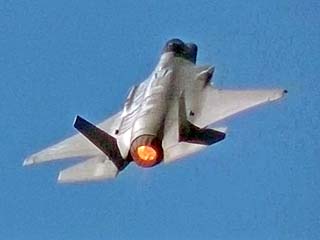
|
An F-35a "Lightning" II fighter selects full afterburner and powers its way into a high-performance climb over Huntington Beach Pier in southern California, at the 2021 Great Pacific Airshow. |
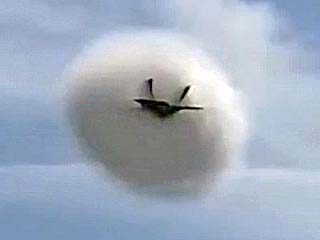
|
An F-35a "Lightning" II fighter does a pass at nearly Mach 1 at the 2021 Great Pacific Airshow in Huntington Beach, California. The shock wave causes a visible "cone" or shock expansion fan to form around the plane as it flies just over the Pacific Ocean. This phenomina is also known to physicists as the Prandtl-Glauert singularity. |
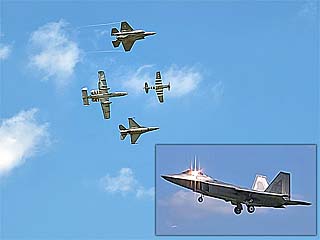
|
This was an airshow at the Ellington Air Force base southeast of Houston, TX in early to mid October 2020. The four planes in formation are (clockwise from left) an A-10 "Warthog", F-22 "Raptor", P-51 "Mustang", and an F-16 "Falcon". An F-35 in the landing configuration is in the lower-right inset. |
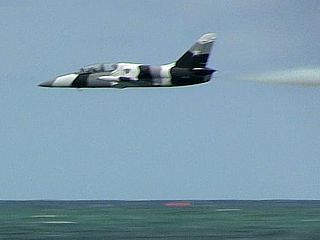
|
This is an L-39 Jet Fighter as part of one of the Black Diamond Jet Team solos. The Aero Vodochody L-39 Albatros is a high-performance jet trainer aircraft developed in Czechoslovakia during the 1960's. In this picture, it is in a 300 Knot low-level pass infront of the crowd at the Fort lauderdale Air And Sea Show in April 2013. |
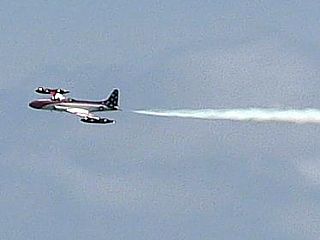
|
This is the Lockheed T-33 Shooting Star doing a high-speed pass at the Fort Lauderdale Air and Sea Show in April 2013. |
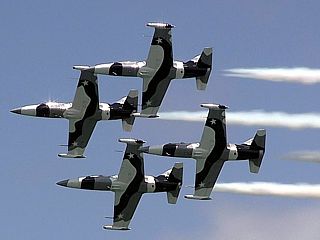
|
Here are four L-39 Jet Fighters in tight formation with the Black Diamond Jet Team at the Fort lauderdale Air And Sea Show in April 2013. |
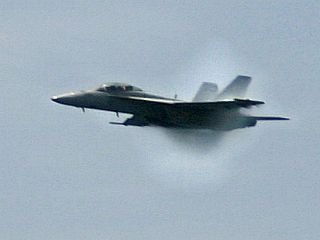
|
This is a still photo of an F18 "Hornet" in a transonic pass (near 750 MPH) at the Fort Lauderdale Air and Sea Show in May 2007. The most striking feature is the development of shock waves around the aircraft, which is very near the speed of sound. These shock waves develop because the faster airflow over the wings is supersonic (relative to the plane) and are made "visible" by moisture in the air condensing (regalation) in their vicinity (due to pressure changes associated with the shock waves). This phenomenon is called the Prandtl-Glauert singularity. |
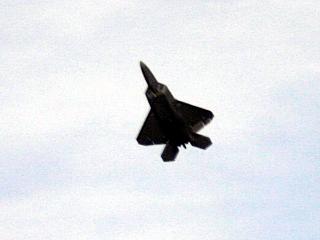
|
This is the F22 "Raptor" aircraft taking off for a demonstration at the Sun N Fun airshow in Lakeland, Florida in April of 2006. This fighter is capable of supersonic flight without the use of afterburners (called "supercruise") and nearly unheard-of performance and maneuevers using a thrust vectoring rear nozzle. Two Pratt and Whitney F-100 series engines, each producing about 30,000 pounds of thrust, powers this fighter, which can actually outperform an F15. The plane also has a very low radar "profile" making it difficult to detect. |
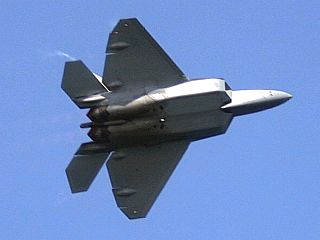
|
This is another picture of the F22 "Raptor" aircraft viewed from below as it passes over the Fort Lauderdale Air and Sea Show in May of 2007. Note that there are no external mountings or pylons to mount weapons as in other fighter jets. Weapons are actually stored behind doors that open only as they are deployed. This, combined with the unique "faceted" airframe, is to both increase performance and reduce its visibility on enemy radar (more steath capability). |
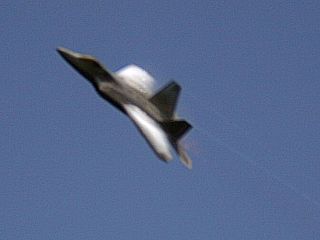
|
Here is a high speed pass (over 650 MPH) of the F-22 "Raptor" at the Fort Lauderdale Air and Sea Show in May of 2007. The sheer speed causes moisture in the air to condense above the wings (from dynamic pressure changes) of this amazing "air superiority" fighter. Also note the small, thin vortex tubes coming off the tail of the aircraft. |
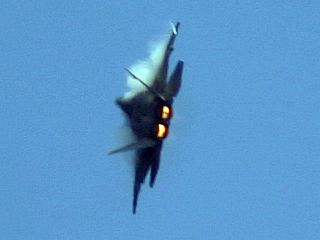
|
This is a picture of an F-22 "Raptor" executing a high-G turn at the Fort Lauderdale Air and Sea Show in May of 2007. The plane has the afterburners lit and their flames are visible as a bright orange glow through the "square-shaped" vectored thrust nozzles on each engine's tailpipe. Note the visible condensation and vortex generation caused by dynamic pressure changes. The moisture in the air undergoes a phase change (condenses to form a white cloud) due to dynamic pressure changes. This is also called "regalation". |
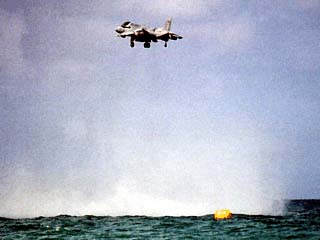
|
This is a picture of a Harrier Jet hovering several hundred feet offshore of Fort Lauderdale Beach, Florida during the Fort Lauderdale Air and Sea Show in May 2004. The jet is less than 100 feet above the water with its Pegasus turbofan engine producing enough vectored-thrust to support the aircraft. Note the spray being kicked up by the hot jet blast hitting the water. A certainly awesome sight with a deafening sound. |
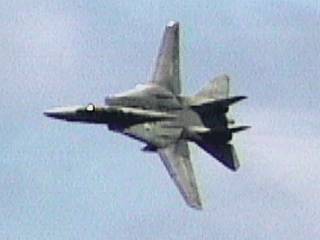
|
This is an F14 "Tomcat" jet fighter aircraft at the Fort Lauderdale Air and Sea Show in May 2002. The F14 is a two-seater multi-roll aircraft, and is carrier capeable. The cockpit houses a pilot and a RIO (Radar Intercept Officer). This aircraft is similar to the F15 in some ways, but one way it is very different: It has a VARIABLE GEOMETRY wing. The wing is hinged and moveable and is extended in this picture. For high speed flight, the wing tips can fold aft, making the wing more of the classic swept-back "delta" shape. The wing is being moved forward in this picture as the plane passes show center. |
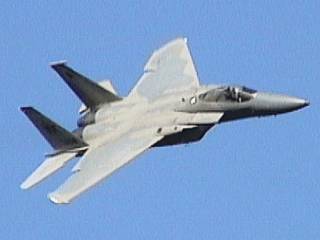
|
This is picture of an F15 "Eagle" jet fighter aircraft at the Fort Lauderdale Air and Sea Show in May 2002. The F15 is a powerful aircraft with two huge afterburning tirbofan engines, each producing over 25,000 pounds of thrust. This translates to high speed, such as over Mach 2.5 and the ability to produce more thrust that the aircraft weighs. An F15 can climb straight up, even muscle its way through the sound barrier while still going straight up! |
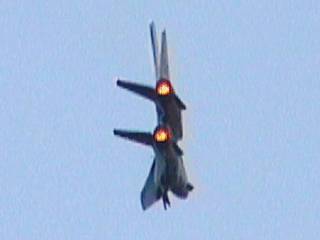
|
Nothing gets an airshow spectators juices flowing like the sound and fury of an afterburning jet fighter! This is a picture of an F14 "Tomcat" doing a minimum-radius turn (nearly 8 g's) at the Fort Lauderdale Air and Sea Show at Fort Lauderdale Beach, Florida in May 2002. In the tight turn, the plane is moving away with the two massive engine tail pipes aimed right at the crowd. The ground shakes, you feel the "crackling roar" in your chest, and look up to see two bright orange flames powering the plane along with nearly 50,000 pounds of thrust. |
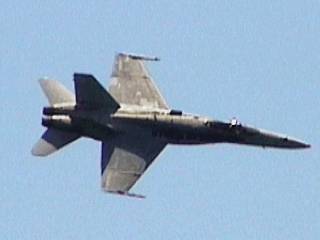
|
This is an F18 "Hornet" jet fighter aircraft at the Fort Lauderdale Air and Sea Show in May 2002. The F18 is one of the aircraft of choice for the US Navy and operates frequently off aircraft carriers. The plane has a destict chine just aft of the cockpit canopy which forms into the front wing root and the two closely mounted turbofan engines in the single-vertical-fin tail. |
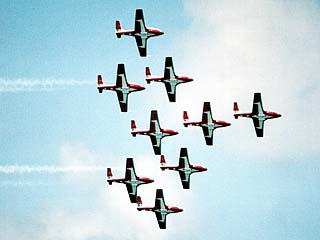
|
The Canadian air force also has a great demonstration team called the Snow Birds. They fly nine jet CT-114 "Tutor" fighters in tight and large formations so precicely, you would imagine the entire formation being "connected" as if it were a single plane! In this picture, the Snow Birds execute a tight delta-arrow formation at the Fort Lauderdale Air and Sea show in May 2004. |
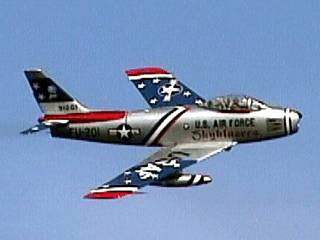
|
This is an F86 "Sabre" jet fighter aircraft at the Fort Lauderdale Air and Sea Show in May 2002. Due to its swept-back wings, the F86 was one of the first planes that could reach supersonic speeds, but only in a steep power-dive due to limited engine / afterburner power at the time. The F86 was around since the 1950's and the one in this picture has been beautifully restored after being retired from the air force with a patriotic paint scheme. The turbojet engine inlet is just below the nose of the plane and exhaust is in the tail. |
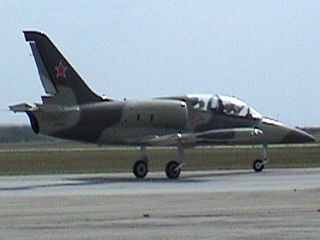
|
This is a picture of an L-39 "Albatross" taxiing into position for take-off for a VIP / demonstration flight at Airglades Airport in Clewiston, Florida. The L-39 is a Czechoslovakian aircraft and can be flown as a full sub-sonic fighter jet aircraft, but was used mainly for training and sometimes is called a "MIG trainer" as it was also used to train Soviet pilots during the cold war (late 1960's to 1970's). Today, over 250 privately-owned L-39 fly in the USA alone, making it one of the most popular "Warbirds". Many are still in military service around the world. I was actually lucky enough to fly in one of these planes - Twice! See my section on FLYING for pictures and more details. |
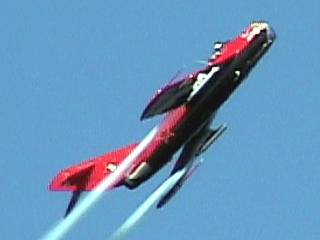
|
A special treat at the Fort Lauderdale Air and Sea Show in May 2002 was the appearance of a Russian Mig 17 jet fighter! This plane, also retired from service, was painted fire-engine red and had smoke generators installed on its wing tips. Like the F86, the turbojet engine has a distinct inlet in the nose and exhaust in the tail, but more available power and afterburning allows supersonic speeds to be reached in level-flight. In this picture, it is in a pull-up into a steep climb at about 450 MPH. |
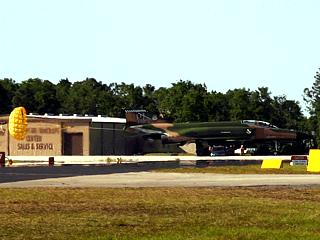
|
An F-4 "Phantom" touches down after a demonstration at Lakeland regional airport in Florida with drag-chute deployed during the Sun n' Fun airshow in April 2005. |
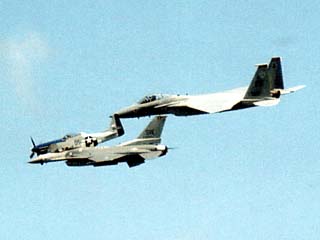
|
Separated by nearly 50 years of aviation technology, an F16 "Falcon" (top), F15 "Eagle" (bottom), and P51 "Mustang" (center-front) fly in close formation separated only by a few feet! These three fighters overflew after the F15 and F16 did a demonstration at the Fort Lauderdale Air and Sea Show in May 2004. The P51 is propeller driven and powered by a Rolls-Royce 12 cylinder Merlin engine producing about 1,700 HP. The F16 and F15 are both powered by the Pratt and Whitney FT100 turbofan jet engine (there are two of these in the larger F15) producing 25,000 pounds of thrust a piece. |
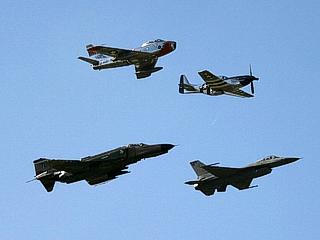
|
About a year later, with now OVER 50 years of flight, a similar formation is celebrated over Lakeland, Florida at the Sun n' Fun airshow. The formation features an F86 "Sabre" (upper left), a P51 "Mustang" (upper right), an F16 "Falcon" (lower right), and an F4 "Phantom" (lower left) separated only by a few feet! These four fighters represent over 50 years of aviation heritage. |
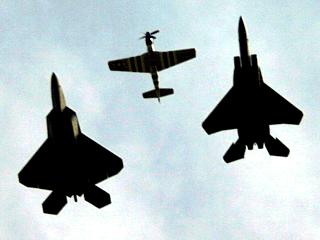
|
In April 2006 in Lakeland, Florida at the Sun n' Fun airshow, a similar performance, silhouetted against the bright sky overhead, adds the F22 "Raptor" (Left) to The formation! A P51 "Mustang" is in the center and an F15 "Strike Eagle" is to the right, separated only by a few feet! These formations gained so much popularity in celebrating over 50 years of aviation heritage that they have become a major part of most airshow programs. |
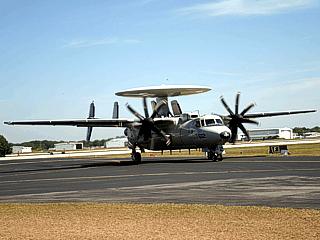
|
An E-2C "Hawkeye" aircraft taxis in front of the airshow crowd in April 2006 in Lakeland, Florida at the Sun n' Fun airshow. The large "pancake" structure on the top of the aircraft is a large radome for a radar antenna. |
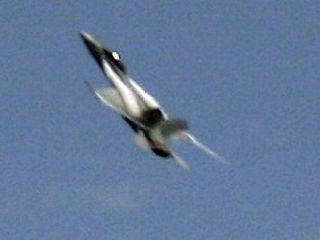
|
Here is a picture of an F-18 "Hornet" suddenly pulling up into a zoom climb at high-G's at the 2007 Fort Lauderdale Air and Sea Show. The plane has just completed a high-speed pass at over 500-MPH and is pulling into the vertical. The most noteable effect besides the afterburner's loud roar are the two "strake vortices" coming off the front chines of the aircraft and over the tops of the wings. Again, moisture in the air condenses due to pressure changes, forming a visible cloud marking the location of the vortices. |
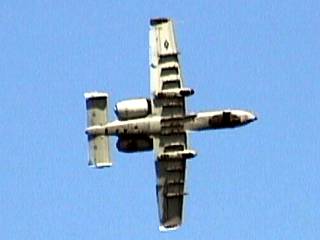
|
This is a picture of an A-10 "Warthog" attack aircraft over-flying Fort Lauderdale Beach, Florida during the Fort Lauderdale Air and Sea Show in May 2002. This rather "ugly" aircraft is a military force you don't want to mess with. With two un-proportionally large rear-mounted turbofan jets and a top speed under 500 MPH, armor and fire-power make this aircraft independent of speed. The plane is literally built around a large cannon under its noze and the cockpit is surrounded by a titanium shell to protect the pilot. Incredible amounts of ordinances can be slung on pods under the wings and the plane can take many hits from enemy fire and still return home. Heat supression in the engine tail pipes also reduce heat-seeking missile threats. Sometimes this plane is referred to as the "Tank Killer". |
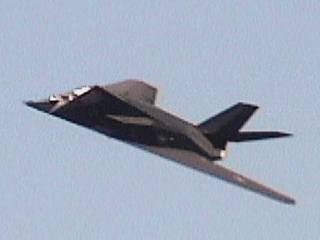
|
This picture shows the famous F117 "Stealth" fighter aircraft doing a fly-by at the Fort Lauderdale Air and Sea Show in May 2002. This sub-sonic attack aircraft is very strange indeed because it uses a faceted airframe that makes it look like it would never be aerodynamically sound. The "facets" and double-wedge airfoils do in fact work, with the help of computers and a fly-by-wire system, and are designed to scatter enemy radar making the plane nearly invisble. Ordinances, such as laser-guided bomb / missiles, are stored in special hatches that open and deploy the weapon when needed. The engines are shielded from any thermal (heat-seeking) attacks, even their inlets hava a grating for this. Finally, the paint of this aircraft is also the worst radar reflector. |
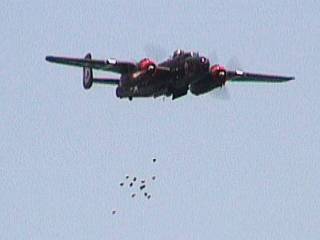
|
This picture shows a vintage B-25 "Mitchell" (strikingly similar to a B-26 "Liberator") bomber aircraft doing an actual bomb-drop (well not exactly, those are watermelons) over the ocean off Fort Lauderdale Beach, Florida at the Fort Lauderdale Air and Sea Show in May 2002. This was a very popular aircraft around the time of World War II, and its appearance at this show took many spectators years back in nostalgic aviation as well. |
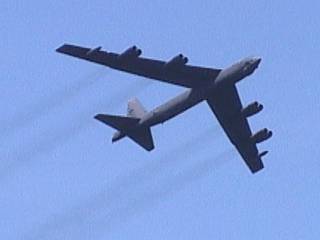
|
This is a picture of a cold-war icon, the B52 "Strato Fortress" bomber aircraft doing a flyby over the Fort Lauderdale Air and Sea Show in May 1998. This was the main stand-by aircraft during the long Cold-War days just in case the "un-thinkable" nuclear war was to occur. The bomber is designed to fly at high altitudes at high sub-sonic speeds for long, long missions (such as from the US to Russia and back). Bombs (nuclear or conventional) were housed in the belly of the plane. Eight (yes eight) turbojet engines, four pods of two-engines each, power this remarkable aircraft and leave a heavy smoke trail in its wake. |
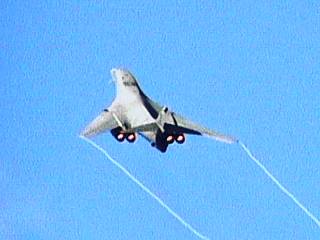
|
This is a picture of one of my personal favorites, the B1-B "Lancer" bomber aircraft. This is a massive bomber with four huge afterburning jet engines. In this picture, taken at the Fort Lauderdale Air and Sea Show in May 1998, a B1-B does a low approach then a steep climb at high speed (over 500 MPH). This plane not only shook the ground, but set off car alarms to boot! The B1-B is a high-subsonic speed aircraft designed for low-level bombing missions. There was a prototype B1-A, with was designed for supersonic flight, but never made it to production. The plane also has a huge variable-geometry wing (swing-wing) that can move back and forth depending on the flight characteristics required. Note the four bright afterburner flames, swept-back wing configuration, and wing-tip vortices in this picture. |
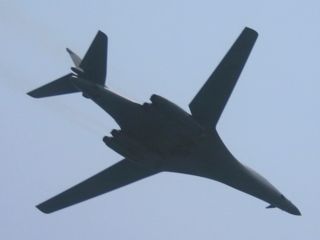
|
Here is another picture of a B1-B "Lancer" bomber aircraft flying overhead at the 2007 Fort Lauderdale Air and Sea Show. The wings here are in the swept-forward configuration. |

|
This picture shows the famous B-2 "Stealth" bomber aircraft doing a fly-by at the Fort Lauderdale Air and Sea Show in May 2002. This plane is basically a flying wing, and there is no tail, actually nothing major protruding from the plane at all. The key feature of this sub-sonic aircraft is STEALTH, meaning it is not meant to be seen by the enemy until it is (or after it is) too late! The plane has smooth fluid lines, bubble cockpit, and a "jagged" trailing edge to supress enemy radar reflections. Heat-supression also has been fitted to the tail-pipes of the engines to reduce heat-seeking missile threats. This makes the enemy radar operator see the "blip" of this plane as a "tree sparrow" instead of a large aircraft on his scope! |
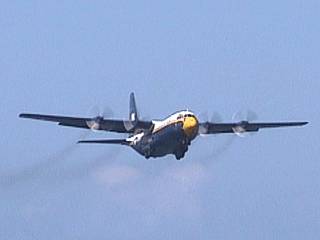
|
Here is a picture of the C-130 "Hercules" aircraft doing a fly-by at the Fort Lauderdale Air and Sea Show in Fort Lauderdale, Florida in May 2002. This is the plane named "Fat Albert" which carries supplies for the US Navy Blue Angels demonstration team. Note the Blue Angels signature white, gold and blue colors. |
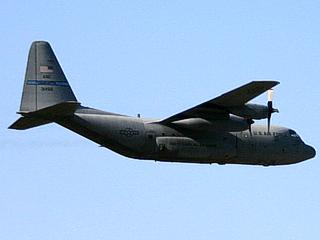
|
Here is another picture of the C-130 "Hercules" aircraft doing a low and fast fly-by at the Sun n' Fun airshow in Lakeland, Florida in April 2005. This C-130 has the typical "military grey" paint scheme. |
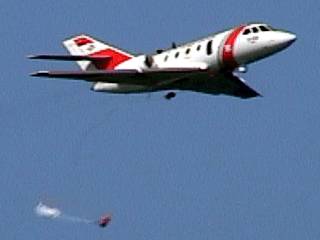
|
This picture shows a Falcon Jet aircraft dropping a rescue package into the ocean just off Fort Lauderdale beach during a US Coast Guard demonstration at the Fort Lauderdale Air and Sea Show in Fort Lauderdale, Florida in May 2002. The Falcon is actually a private civilian jet but is the aircraft of choice for reconaissance and rescue operations around the US coastlines. The plane is doing a low-speed pass in this picture and is dropping a rescue supply kit (raft, food, etc) via parachute into the sea. |
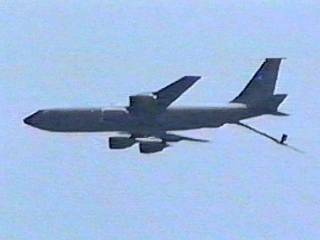
|
Here is a picture of the KC-135 tanker aircraft doing a fly-by at the Fort Lauderdale Air and Sea Show in Fort Lauderdale, Florida in May 1998. The KC-135 is essentially a variant of the C-135, a 4-engined military (NATO designation) of the Boeing 707 (with many modifications, ofcourse). The picture here shows the plane with the refueling boom deployed. The plane is important when missions require mid-air refueling such as during long flights over bodies of water. |
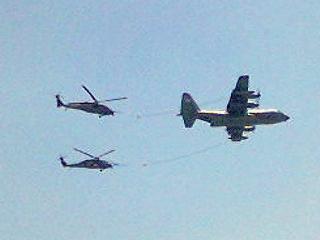
|
Here is another picture of a tanker, a KC-130, doing a fly-by with two Sikorsky Blackhawk helicopters in refueling mode at the Fort Lauderdale Air and Sea Show in Fort Lauderdale, Florida in May 2006. The KC-130 is also a variant of the C-130, a 4-engined turboprop military (NATO designation) aircraft. The picture here shows the plane with both wing-tipped refueling probes deployed. |
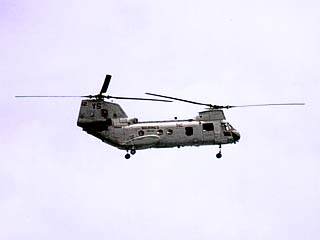
|
Here is a picture of one of four C-46 "Sea Knight" helicopters helicopters operated by the US Marines doing a fly-by at the Fort Lauderdale Air and Sea Show in May 2004. This large twin-rotor helicopter has large troop and heavy lifting capabilities. It is also very similar to the AH-47 "Chinook", another variant of this twin-rotor design. |
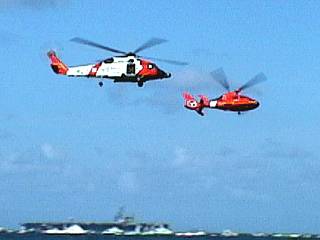
|
Two helicopters of the US Coast Guard fly past show-center of the Fort Lauderdale Air and Sea Show in May 2002. The helicopter to the left is the HH-60J Jayhawk and the other is a Dauphin HH-65A. Both these helicopters have missions ranging from short-range reconaissance to search-and-rescue missions. |

|
A Sikorsky Blackhawk helicopter of the US Navy SEALs hovers off Fort Lauderdale beach at the Fort Lauderdale Air and Sea Show in May 2002. In this picture, the helicopter has dropped a line so SEAL units can rappel down it to the sea surface. |
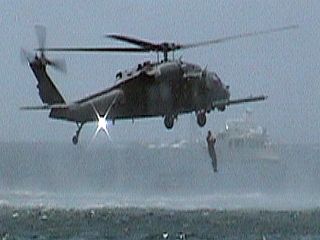
|
A rescue swimmer of the US Navy SEALs drops from a Sikorsky Blackhawk helicopter hovering off Fort Lauderdale beach at the Fort Lauderdale Air and Sea Show in May 2007. This is part of the Navy SEALs search and rescue demonstration. |
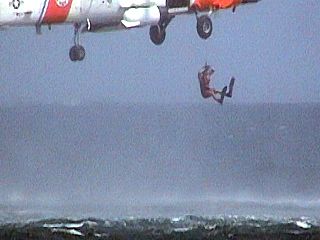
|
A similar rescue demonstration by the United States Coast Guard drops a rescue swimmer from a HH60 "Jayhawk" helicopter off Fort Lauderdale beach at the Fort Lauderdale Air and Sea Show in May 2007. To these brave men serving our coastal waters, this demonstration (in light sea and wind conditions) is just another "walk in the park"! |
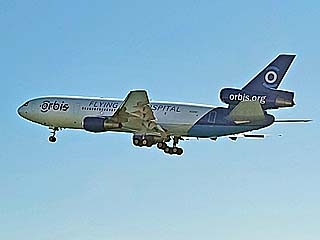
|
This is a picture of the Orbis MD-11 "flying hospital" aircraft doing a flyby at the Great Pacific Airshow in Huntington Beach, California in October 2021. |
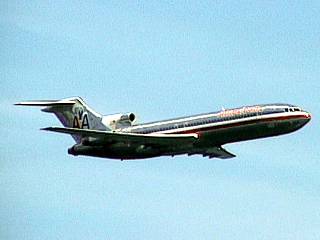
|
This is a picture of the tried and true Boeing 727 aircraft doing a fly-by at the Fort Lauderdale Air and Sea Show in Fort Lauderdale, Florida in May 2002. This plane has a descriptive "T-tail" and three rear-mounted turbofan jets, with the centerline jet with its inlet in the root of the tail and exhaust nozzle aft and below. The Boeing 727 was a very popular aircraft for medium range flights from the late 1970's through the mid 1990's and many are still flying today. American Airlines is the operator of the Boeing 727 shown here. |
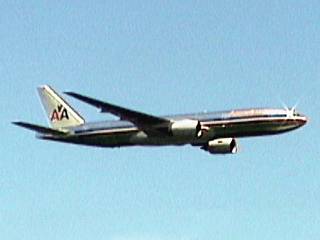
|
This picture shows the Boeing 777 jumbo-jet aircraft also doing a fly-by at the Fort Lauderdale Air and Sea Show in Fort Lauderdale, Florida in May 2002. This plane is large, and designed to operate over seas with only two engines, two very large turbofan jets to be exact. Each engine is rated in the 75,000 to 110,000 pounds-thrust class and the cabin interior rivals that of the first deck in the Boeing 747. This aircraft made its debut in the late 1990's and should be flying well into the 21st century. The operator of the Boeing 777 here is also American Airlines. |
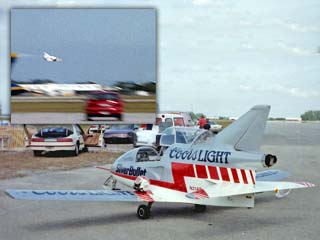
|
This is a BD-5J (Jet version) "kit" aircraft at the 1991 Miami Airshow in Dade County, Florida. The "Bede" BD-5 Micro is a series of small, single-seat homebuilt aircraft designed by Jim Bede and was originally powered by a piston engine. This is the Coors Silver Bullet jet version, where the piston engine was replaced by a French TRS 18 missile turbojet producing just under 300 LBS of thrust. This allowed the aircraft to reach speeds over 300 MPH. The BD-5J also appears in the opening scene in the 1983 James Bond movie "Octopussy". |
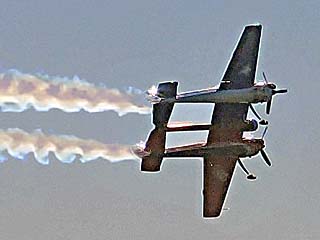
|
What on earth is this? A P-38 Lightning? No - It's a Yak-110, and an awesome demonstration of "experimental" aircraft at the 2021 Great Pacific Airshow over Huntington Beach, California! A group of engineers (Boerboon & Coller) decided to take two Russian Yak 55s, each powered by two radial 360 HP engines, and "mate" them together. If that wasn't cool enough, they added a spare GE J-85 jet engine (with afterburner!) in the centerline axis between the two planes! Truly a unique and exilerating entry into the airshow circuit. |
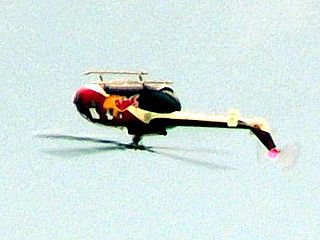
|
This is a picture of the RedBull BO-105 helicopter upside down in a loop / roll at the Fort Lauderdale Air and Sea Show in April 2013. This unique aircraft is one of the only helicopters than can perform aerobatics. |
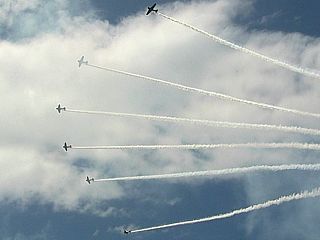
|
These are the Geico Skytypers flying T-6 Texans in formation at the Fort Lauderdale Air and Sea Show in April 2013. |
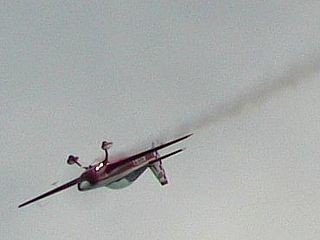
|
Here is an Extra 300 aerobatic plane in a dive and about to enter an outside loop at the Fort Lauderdale Air and Sea Show in April 2013. |
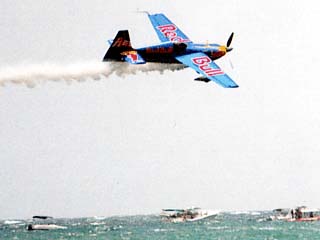
|
This is an Edge-540 aerobatic aircraft flown by Kirby Chambliss doing a sliding low-approach at the Fort Lauderdale Air and Sea Show in May 2004. The Edge 540, developed by Zivco Aeronautics in Oklahoma, USA, is a very similar aircraft to the German Extra 300, but with weight and material improvements. In this picture, the sponsor is "Red Bull" with the blue and red colors. |
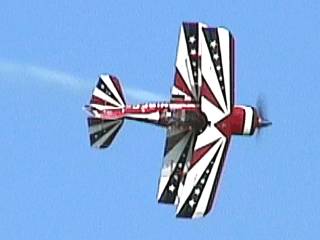
|
This is the Pitts Special S2-B aircraft performing at the Fort Lauderdale Air and Sea Show in May 2002. The Pitts Special here is a two-seater, high-performance, aerobatic bi-plane powered by a Lycoming 260 HP engine. In this picture, owner and pilot Fred Cabanas is performing a knife-edge pass in front of show center. I was even personally lucky enough to fly in this plane with Fred Cabanas at Island Aeroplane Tours in Key West, Florida! |
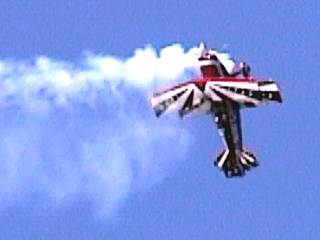
|
Here is another picture of Fred Cabanas in his Pitts S2-B bi-plane doing a "lum-shibock" (means "headache" in German) meneuver in front of show center at the Fort Lauderdale Air and Sea Show in Fort Lauderdale, Florida in May 2002. The meneuver consists of a snap roll, and in this picture, the plane is moving to the right while cart-wheeling! |
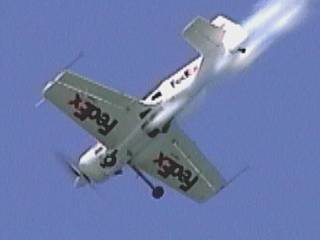
|
This is the Sukoi SU-31 aircraft performing at the Fort Lauderdale Air and Sea Show in May 2002. This is a Russian aircraft, and capeable of un-imaginable (and probably un-bearable) g-forces and designed for "Arestii" aerobatics (meaning that you have to stay within a 1,000 meter, or 3,300 foot, cube in the sky called a "box"). Pilot Ian Groom is performing a show-center fly-over with his Federal Express sponsored SU-31. Tragically, Ian Groom lost his life in this same aircraft on April 30, 2004 while practicing aerobatic routines for the 2004 Air and Sea show. |
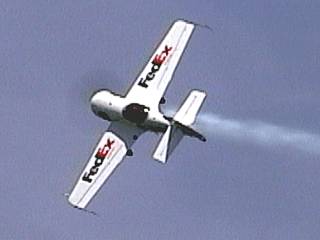
|
This is the Sukoi SU-31 aircraft performing a 45 degree sliding bank meneuver at the Fort Lauderdale Air and Sea Show in May 2002. The pilot is Ian Groom and his fine SU-31 aircraft is sponsored by Federal Express. Ian was able to spin this plane 57 times in 20 seconds setting a world record that still stands - That's over 1000 degrees per second! |
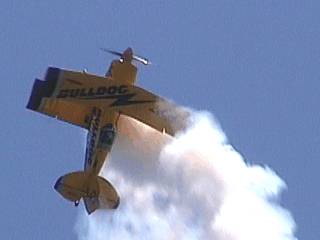
|
This is a picture of a modified Pitts S2-S aircraft in a hammer-head stall meneuver at the Fort Lauderdale Air and Sea Show in May 2002. The pilot is Jim Leroy and he is noted for flying his aircraft to is maximum limits. Jim Leroy's Pitts S2-S in this picture, sponsored by Bulldog, has been highly modified, including clipped-wings and a larger engine. He is at the top of the stall where he is reducing engine power and starting to slide back into his own smoke trail. |
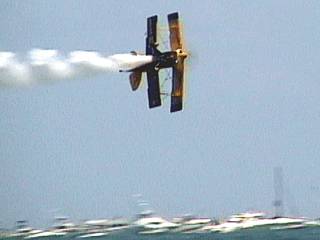
|
Here is another picture of Jim Jim Leroy and his Pitts S2-S aircraft in a knife-edge low-pass meneuver at the Fort Lauderdale Air and Sea Show in May 2002. In this picture, he is about 30 feet above the ocean of Fort Lauderdale beach and doing about 195 MPH. |
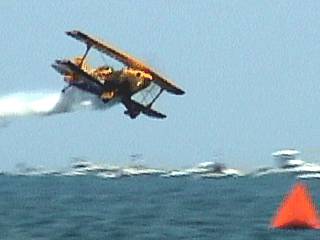
|
Here is yet another "white-knucked" picture of Jim Leroy and his Pitts S2-S aircraft in a high-speed low-approach just off Fort Lauderdale beach at the Fort Lauderdale Air and Sea Show in May 2002. Here he wows the crowd at show center after pulling out of a steep-dive less than 20 feet above the water, going over 200 MPH, only to climb into another vertical "line". |
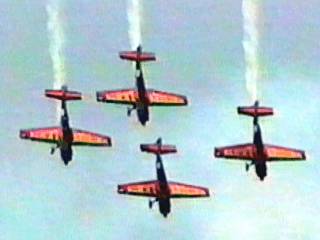
|
This is a picture of one of another personal favorite, the Northern Lights demonstration team. In this picture four Extra-300 aircraft fly in tight diamond formation and execute a loop. The Northern Lights are a precision flying team, from Canada, and demonstrate some of the finest precision meneuvers in the German Extra-300 high-performance aircraft. The Nothern Lights made an appearance at the Fort Lauderdale Air and Sea Show in May 1998. |
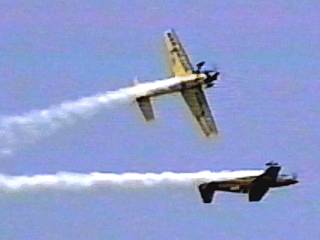
|
Two Extra-300 airplanes of the Northern Lights team demonstration team demonstrate a really interesting meneuver. There are two Extra-300 airplanes. One plane flies straight but inverted, while the second executes a barrel roll AROUND the axis of the first plane. This meneuver wrapped up the demonstration of Nothern Lights team at the Fort Lauderdale Air and Sea Show in May 1998. |
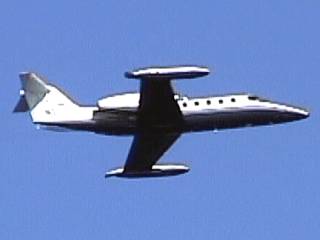
|
A learjet (Lear 35) makes a fly-over at the Fort Lauderdale Air and Sea Show in May 2002. This is a very popular and powerful business (private) jet. It is rather small, and light, therefore it can climb at nearly 7,000 feet per minute. It is designed to cruise at about 41,000 feet carrying business owners and associates in luxury at about 500 MPH. |
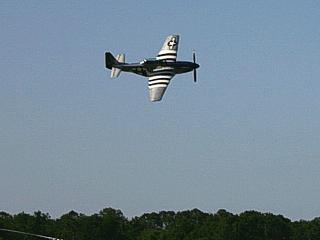
|
A P51 Mustang makes an incredibly fast low approach over Lakeland, Florida at the 2005 Sun N' Fun airshow. Here the aircraft is flying at over 400 MPH (remember this is a propeller powered aircraft, not a jet). A supercharged Rolls Royce V12 (12-cylinders producing at least 1,700 HP) Merlin engine powers this powerful classic aircraft. |
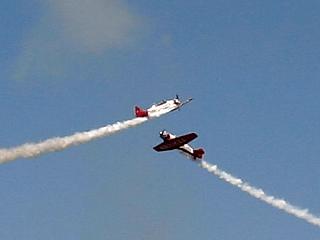
|
The Aeroshell Team flies four T-6 "Texan" aircraft. In this picture, two of the T-6 aircraft are doing a breath-taking crossover meneuver at the 2005 annual Sun n' Fun airshow in Lakeland, Florida. |
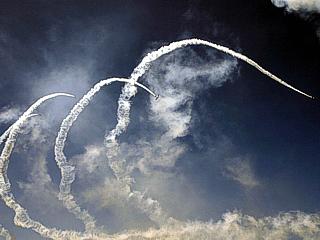
|
Here is a picture of the same Aeroshell team with the four T-6 "Texans" performing simultaneous half Cuban 8's at the 2005 Sun n' Fun in Lakeland, Florida. |
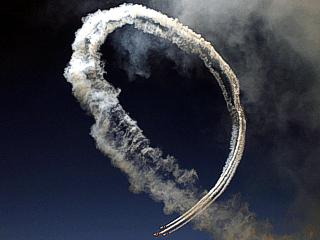
|
Here is a picture of a majestic loop flown by all four T-6 "Texans" of the Aeroshell team at the 2005 annual Sun n' Fun airshow in Lakeland, Florida. |
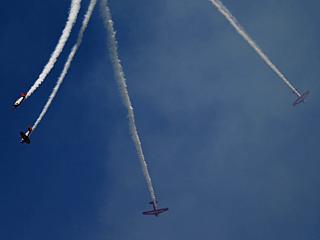
|
This picture shows team Aeroshell performing a downward "bomb-burst" meneuver to patriotic music over Lakeland, Florida for the 2005 Sun n' Fun airshow in April 2005. |
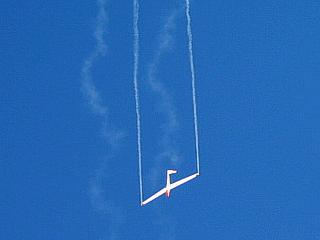
|
A high-performance glider, performs its silent and powerless meneuvers after being released from a tow-plane about 6,000 feet over Lakeland, Florida. This glider, also called a sailplane, was fully aerobatic (it is just out of a hammer-head stall when this picture was taken) and even was able to perform a ribbon-cut during a low approach! |
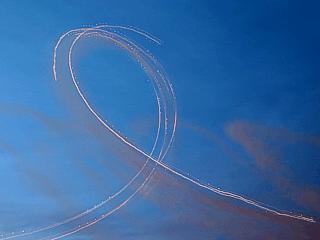
|
The Aeroshell Team performs a twighlight airshow over Lakeland, Florida with their T6 "Texan" aircraft. The planes have all completed a loop and appear as streaks of light since the image is a 10-15 second time exposure. Sun n' Fun in April 2006 featured an incredible night time airshow. |
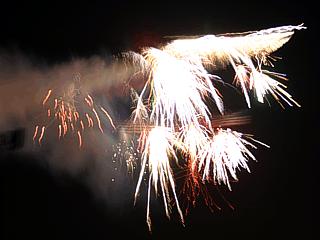
|
Here is a time exposure of a Bell 47 helicopter launching smoke and pyrotechnics (fireworks) while proudly flying the American flag through the night sky over Lakeland, Florida during Sun n' Fun in April 2006 during the night airshow. |
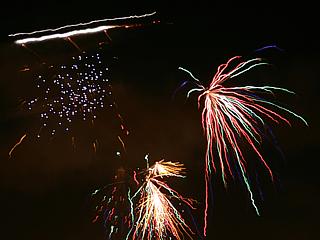
|
This time exposure image is a Piper Cub shooting off fireworks during the Sun n' Fun night airshow in April 2006 at Lakeland, FL. The actual aircraft launching the pyrotechnics is the streak in the upper-left side of the image. |
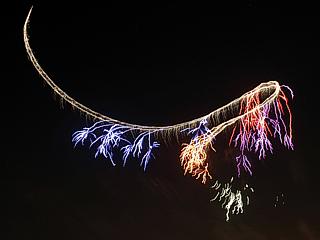
|
Here is another time exposure taken during the Sun n' Fun night airshow in April 2006 at Lakeland, FL. The unique effect (for a 15-20 second exposure) is produced by an aircraft with lights, smoke, and pytotechnics launched from wing-mounted pods. A night airshow is a very unique experience. |
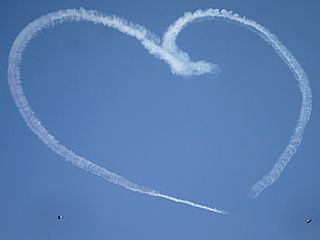
|
The "Red Baron Pizza Squadron" flies four Stearman bi-planes in some more incredible acts. In this picture, two of the planes have just completed a "heart in the sky" with smoke trails on at the Air and Sea Show in Fort Lauderdale, Florida in May 2007. |
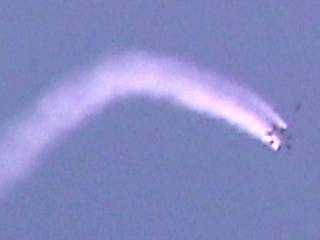
|
This is a picture of the US Army Golden Knights skydiving demonstration team after just exiting a C-130 aircraft 12,500 feet over the Fort Lauderdale Air and Sea Show in May 2002. This is a highly-zoomed video frame grab, but you can still see seven skydivers in a Relative Work (RW) "star" formation with the camera-man flyer just above and slightly right of the formation. Note the "parabolic curve" or what skydivers call the "hill" created by the smoke trails. |
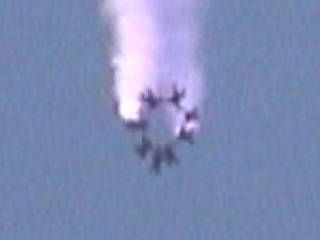
|
After roughly 45 seconds of free-fall, and still about 5,000 feet over the Fort Lauderdale Air and Sea Show in May 2002, the "7-star" RW formation plus camera-man of the US Army Golden Knights becomes somewhat clearer just before "break-off" (when each jumper turns 180 degrees and tracks away to gain some distance before opening the main parachute). The smoke-generators are attached to the feet of each of the units, and produce about 1 minute of white non-toxic smoke. |
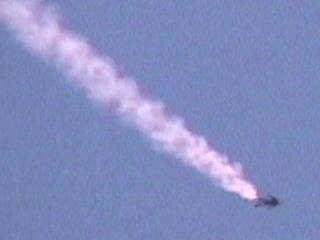
|
After break-off, this picture clearly shows the strong tracking of one of the US Army Golden Knights team until parachute deployment about 2,500 feet over the Fort Lauderdale Air and Sea Show in May 2002. Note that the skydiver, marked by the smoke cartridge attached to his right foot, in this picture is not only falling vertically at nearly 120 MPH, but also moving horizontally at over 90 MPH too! |
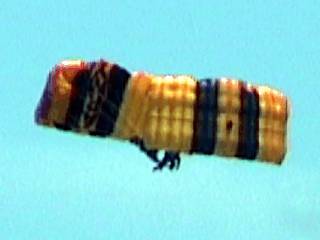
|
Once under a good canopy (called a ram-air parachute), two members of the US Army Golden Knights team perform Canopy Relative Work (CReW) at the Fort Lauderdale Air and Sea Show in May 2002. In this meneuver, the two skilled skydivers attach their legs and push their canopies into a down-plane, then straight-down at nearly 70-MPH! |
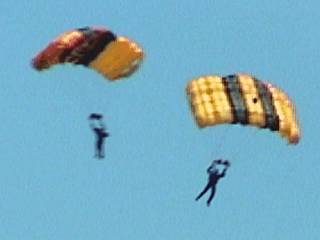
|
Once close to the ground, say at about 1,000 feet or less, the two members of the US Army Golden Knights team break off of the CReW meneuver and return to normal canopy flight over the Fort Lauderdale Air and Sea Show in May 2002. I am a skydiver myself and have flown many ram-air (square) canopies for years and I still appreciate what these skilled military performers can do. |
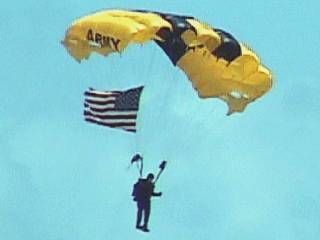
|
A proud team member of the US Army Golden Knights prepares for a beach-landing the Fort Lauderdale Air and Sea Show in May 2002. The jumper is destined to land in a designated area called a DROP ZONE and must be proficient at judging wind and canopy behavior. The American US flag is unfurled after collapsing the slider of this parachute to present a patriotic entrance and kick-off the start of the air show, which is a salute to the US Military. |
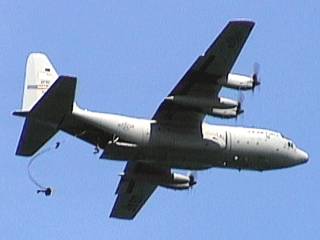
|
This is a picture of the US Navy SEALs "Leap-Frogs" demonstration team and their drop-aircraft, a C-130 "Hercules". At about 750 feet off Fort Lauderdale beach at the Fort Lauderdale Air and Sea Show in May 2002, a jumper can be seen exiting the aircraft via the tail ramp and once in free-fall, his canopy is activated (parachute opened) via a static line. This type of jump is designed for rescue and precision drops, and involves minimal "free-fall" time. |
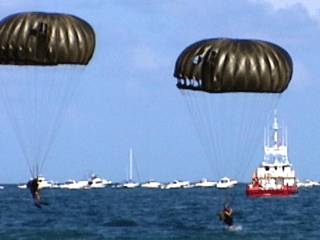
|
Two members of the US Navy SEALs "Leap-Frogs" demonstration team perform an intentional water landing off Fort Lauderdale beach at the Fort Lauderdale Air and Sea Show in May 2002. Each jumper exited from a C-130 jump-aircraft via static line at low-level and is not parachuting into the sea using a round canopy. The next phase of their mission could be a rescue or even a war-time mission in real life. Wanna become a SEAL? The US Navy SEALs are one of the toughest programs known to military cadets. |
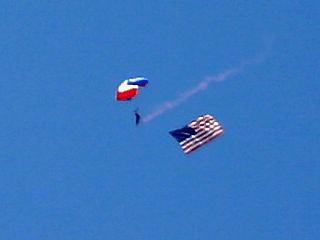
|
A paratrooper under canopy proudly flies the American flag high over Lakeland, Florida during the opening ceremonies of the weekend airshow at the 2005 Sun n' Fun fly-in. |
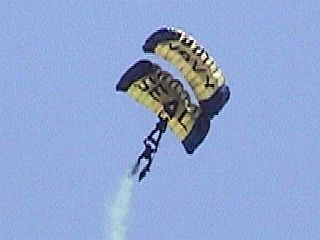
|
Here are two members of the US Navy SEALs "Leap-Frogs" at the Fort Lauderdale Air and Sea Show in May 2007 doing a "bi-plane" meneuver where two ram-air canopies are stacked. This is another form of CRW (Canopy Relative Work). |
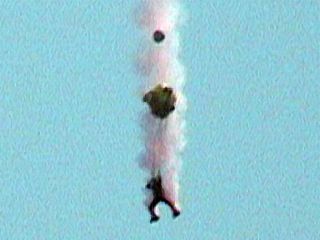
|
This is a picture of one of the members of the US Navy SEALs "Leap-Frogs" opening his main parachute at about 2,500 feet at the Fort Lauderdale Air and Sea Show in May 2007. You can see the pilot chute, a smaller parachute that pulls the main out of its "container" via a "bridle" (ribbon-like rope). In this picture, the main has not yet fully inflated, and the jumper is experiencing deceleration forces anywhere from 3 to 9 G's. The smoke generators are attached to the jumpers boots. |
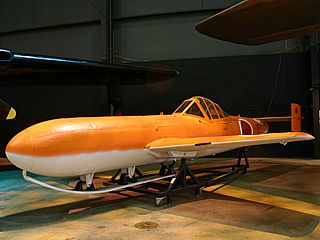
|
Here is a very interesting type of aircraft. Actually, it is more of a weapon than an aircraft. This is an Ohka Model 22 on display at the US Air Force Museum near Dayton, Ohio. The purpose of this aircraft was blatently evil ... Take a suicide and poorly trained Japanese pilot (Kamikaze), put him in this vehicle (which is also a bomb containing up to 2,650 pounds of high explosive), and have him fly INTO the enemy! The aircraft / weapon was powered either by a turbojet engine or three rocket engines, and during a final dive, reached speeds near 650-MPH, making it hard to shoot down. Note the skid in the front of the aircraft belly as well. This is certainly a one-way ticket for all those who chose to fly it. |
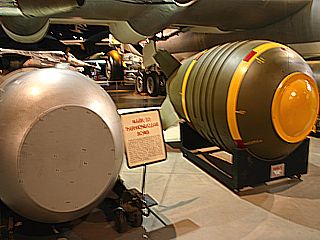
|
This is a picture of two thermonuclear (hydrogen) bombs (inert, or non-functional) on display at the US Air Force Museum near Dayton, Ohio. The bomb to the left is a Mark-53 weapon. Both are in the well-feared megaton range, and are aircraft deliverable (designed to be flown aboard bomber aircraft such as the B-52 or B-58). Both bombs can be parachute retarded or free-fall until impact / detonation. A version of the Mark-53 could also be delivered by ICBM as well. |
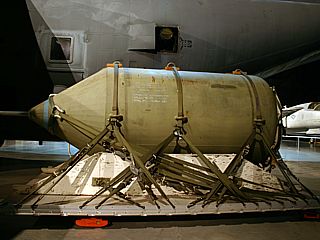
|
This is a BLU-82 "Daisy-Cutter" fuel-air bomb on display at the US Air Force Museum near Dayton, Ohio. The bomb here is on a palette so that it can be dropped by standard parachute-extraction from a heavy aircraft, such as a C-130, from at least 6,000 feet AGL for safety. The bomb weighs 15,000 pounds, and is one of the largest and most powerful non-nuclear weapons in the US arsenal (there are still some larger weapons today). The bomb is filled with a slurry of ammonium nitrate, styrofoam, and aluminum powder (GSX mix) and is detonated by the "plunger" rod seen extending to the left from the nose of the case. The bomb was used for jungle clearing (such as in Vietnam) and anti-personnel (as in Afghanistan). The lethal blast radius is at least 900 feet, but leaves almost no crater. |
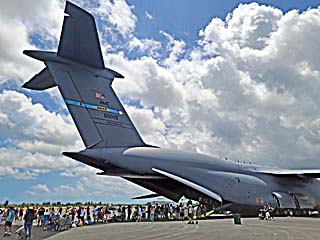
|
Massive "T-Tail" of the rear of a C-5 Super Galaxy aircraft at the Wings over Homestead airshow in Homestead, Florida in early April 2023. |
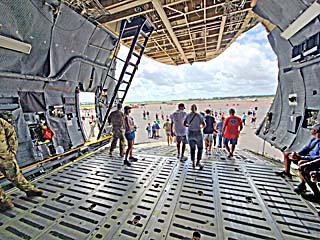
|
Walk-through of the massive, "shopping-mall like" interior of the C-5 Super Galaxy aircraft at the Wings over Homestead airshow in April 2023. The ladder to the left (guarded) goes up to the upper-deck including the flight deck and VIP seating area called a "peanut gallery". |
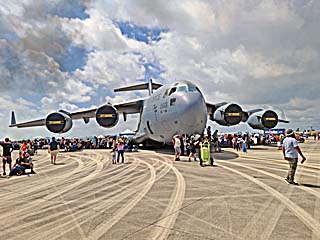
|
C-17 on display at the Wings over Homestead airshow in April 2023. |
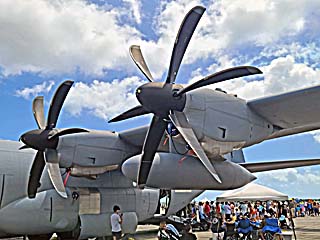
|
WC-130 wing, propellers, and external fuel tank for the Hurricane Hunters (USAF 53rd Weather Recon Squadron) from Biloxi, Mississippi. This plane was on display at the Wings over Homestead airshow in April 2023. |
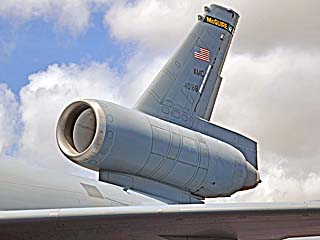
|
Number 2 engine through the tail of a KC-11 tanker aircraft at the Wings over Homestead airshow in April 2023. |
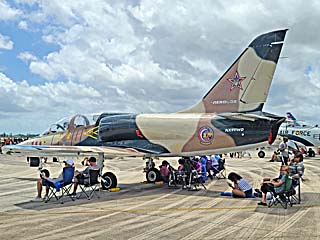
|
L-39 "Mig trainer" on display at the Wings over Homestead airshow in April 2023. |
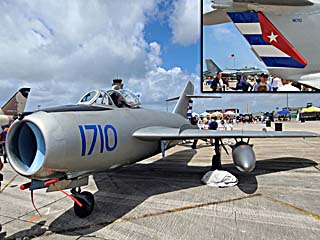
|
Mig 17 (from the Cuban Revolutionary Air and Air Defense Force) on display at the Wings over Homestead airshow in April 2023. The Cuban flag is on the vertical tail-plane in the upper-right inset. |
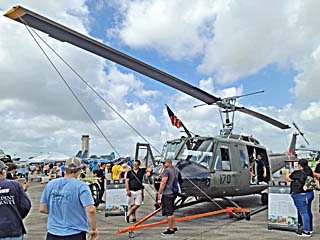
|
A UH-1H "Huey" helicopter on display at the Wings over Homestead airshow in April 2023. This one pictured here flew nearly 2,400 hours of service in Vietnam from 1968 to 1971. |
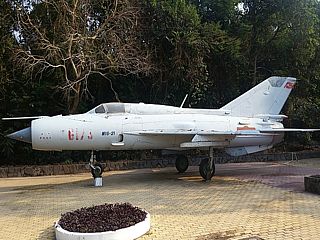
|
Mig-21 jet fighter on static display at the entrance to the Cu Chi tunnels northwest of Ho Chi Minh city in March of 2016. |
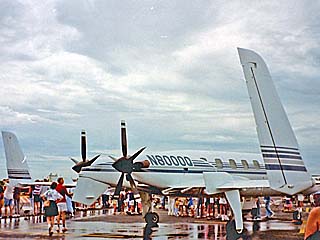
|
This is a Model 2000 "Starship" on display at the Boca Raton airshow and weekend in late 1993. The twin rear "pusher" propellers can be seen, each powered by Pratt and Whitney (Canada) PT6A-67A engines, at 1,200 shaft HP each. This aircraft, designed by Burt Rutan (Scaled Composites), also had distinct canards in the front of the fuselage, as well as vertical / rudder control surfaces on the wing-tips instead of the central tail. Maximum speed was just under 400 MPH with a ceiling of 41,000 feet MSL. |
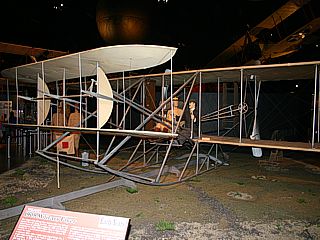
|
This is one of the very first aircraft, built by the Wright Brothers in 1909 called the Wright 1909 flyer. This is on display at the Air Force Museum neat Wright Peterson Air Force Base near Dayton, Ohio. Contrary to most beliefs on where the "Wright Brothers" are originally from, they are NOT from North Carolina, but Dayton, Ohio. The first successful flight took place at Kitty Hawk, North Carolina. Dayton, Ohio is also home to the World's very first airport. As the first TRUE military aircraft (US Army), the Wright 1909 flew at 42 MPH and was powered by a 30 HP engine. Note the "tailplane controls" (elevator) are in FRONT of the aircraft, rather than behind it as with most aircraft today. |
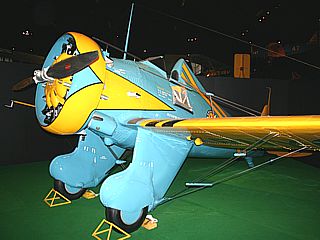
|
Here is a picture of a P-26 "Pea Shooter" aircraft on display at the USAF Museum. This is among the first all-metal fighter production aircraft used by the US Army in 1932, and most importantly, as late as 1941 in the Phillipines. It has a top speed of 234 MPH and is powered by a 600-HP Pratt and Whitney "Wasp" radial engine. |
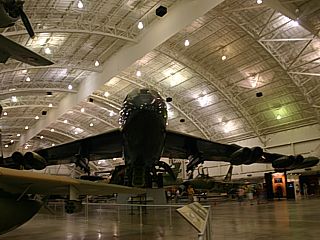
|
This is a Boeing B-52 "Stratofortress" at the US Air Force Museum near Dayton, Ohio. The B-52 is a long-range bomber aircraft with a 185 foot wingspan, a 650-MPH top speed (high subsonic), and a service ceiling over 55,000 feet. Eight Pratt and Whitney TF-33 low-bypass turbofan engines (pairs of two in two nacelles under each wing) each produce 17,000 pounds of thrust. The plane has a range of up to 11,000 miles, can refuel in flight, and carry at least 60,000 pounds of armament / bombs. The B-52 is another cold-war icon still flying today. |
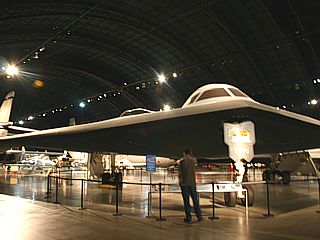
|
This is a Northrop (Grumman) B-2 "Spirit" bomber at the US Air Force Museum near Dayton, Ohio. The plane here is actually a static "mock-up", not a replica, but an actual prototype airframe that was used for development and extreme structural testing. The nose-wheel hatch artwork says "Fire and Ice". The B-2 was one of the most successful "flying wing" concepts ever developed, with it's maiden flight (after development in secrecy) in 1989. The huge flying wing has a wingspan of 172 feet, and four General Electric F-118 17,300 pounds-thrust turbofans powers the aircraft. With a ceiling of 50,000 feet and a speed of no more than 500-MPH, the main advantage and defense of this bomber is stealth. The radar signature of this aircraft, called a radar cross-section, looks more like a "bird" than a large plane to enemy radar. By the time (and if) one sees the aircraft approaching on its attack (bombing) run, it's often far too late. |
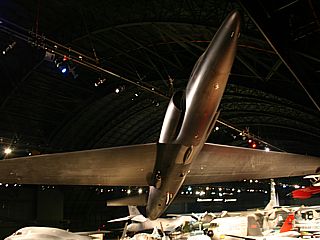
|
This is a Lockheed U-2 "Dragon Lady" surveillance aircraft. The U-2 is designed to be a high-altitude reconaissance aircraft and is powered by a single 17,000 pound-thrust J-75 turbojet by Pratt and Whitney. The plane flies no faster than a commercial airliner (under 510-MPH) but as much as three times as high (up to 90,000 feet). The plane's main role nowadays is high-altitude research and surveillance ... Most U-2's are owned by NASA for this purpose. Another interesting aspect is the "coffin corner" pilots aboard a U-2 at altitude had to deal with. The subsonic aircraft had a maximum mach-limit (high-speed buffet) that was only 5-10 Knots above the stall speed (low-speed buffet) of the aircraft! Note the two engine inlets on each side well ahead of the root of the long wings in this picture. |
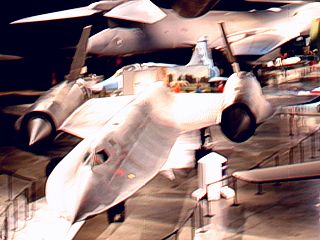
|
The SR-71 "Blackbird" is by far one of the fastest jet aircraft ever built. There is one on display at the US Air Force Museum near Dayton, Ohio. The SR-71 "Blackbird" is all-titanium and built by Lockheed's "Skunk Works" and not designed to be "seen or even heard". With an operating altitude of up to 85,000 feet, and speeds faster than a high speed military rifle bullet (sustained Mach 3.3 flight / 2,200 MPH+), this reconnaisance aircraft is difficult to even detect, let along try to shoot down. The aircraft is also a lousy radar reflector as well. Two Pratt and Whitney J-58 turbo-ramjets power this aircraft with 32,500 pounds of thrust each. The aircraft becomes very hot at speed and altitude, and fuel leaks from the tanks (when the plane is cool and lower / parked) until this heating stretches the planes "skin" and "seals" the leaking areas! The engines burn high-flashpoint JP-7 fuel, ignited by triethylborane, which also serves as a coolant (which pre-heats the fuel) as well. Also, the plane has a rate of climb of well-over 2 miles per minute (11,810 feet-per-minute)! |
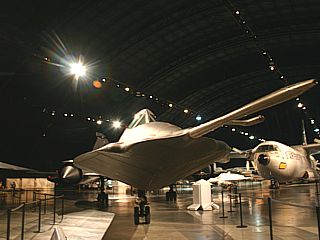
|
This is a is a picture of the nose of the SR-71 "Blackbird" and "aerospike", looking aft, at the US Air Force Museum near Dayton, Ohio. The SR-71 has a unique "chined and sponsoned" shape to its body with a small triangular canopy atop for the single pilot. The rudders are above the huge engine nacelles on the wing and there is no tail-plane at the rear of the aircraft. The SR-71 is still used today by NASA for high-spped flight research as well as limited reconnaisance over high-tension political areas (such as North Korea). |
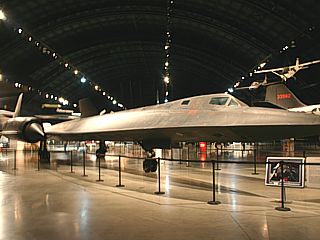
|
Here is another picture of the SR-71 "Blackbird" at the US Air Force Museum near Dayton, Ohio. The plane is a sleek and unique piece of aerospace engineering. Note the lack of a true tail plane and the rudder controls above each engine nacelle housing the J-58 engines. The large inlet cone of the engine intake can also be seen the the left. The thin (chined) edges / smooth surfaces of the SR-71 are primarily so the plane can "knife" through the air at Mach 3+, but also happen to be a horrible radar reflector as well. |
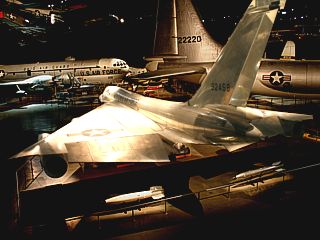
|
This is a B-58 "Hustler" aircraft on display at the US Air Force Museum near Dayton, Ohio. The Convair B-58 is a high-speed (supersonic) cold-war bomber aircraft, and has a service ceiling of over 63,000 feet and a top speed of at least 1,600-MPH. Four afterburning GE J-79 turbojets power the aircraft. The plane here (#59-2458, also called "Cowtown Hustler") is one of only eight still in flight-worthy condition. |
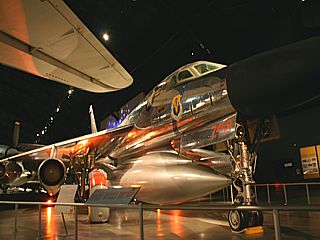
|
Here is a picture of the nose (note the large radome), starboard wing root, and large bottom fuel tank of the B-58 "Hustler" at the US Air Force Museum near Dayton, Ohio. With a wingspan of nearly 57 feet and a length of almost 97 feet, try to imagine the sonic boom this plane had to make during a low-level high-speed run! |
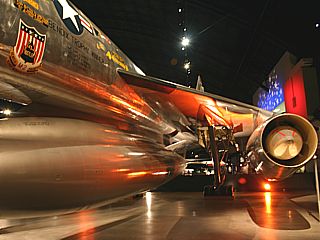
|
Here is another picture of the port-side of the fusalage, wing root, large bottom fuel tank, and engine inlet of the B-58 "Hustler" at the US Air Force Museum near Dayton, Ohio. Note the large inlet "cone" of the GE J-79 turbojet nacelle to the right. |
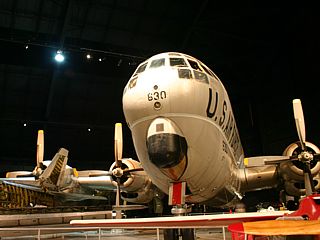
|
This is the nose / cockpit section of a KC-97 variant (similar to the B-29 "Superfortress", but a tanker / cargo version based on the Boeing "Stratocruiser") on display at the US Air Force Museum near Dayton, Ohio. The aircraft here has a larger "belly" to accomodate extra payloads such as fuel (in the tanker version) and / or cargo. The KC-97 (and similar B-29) can fly as high as 33,600 feet, can fly over 350-MPH, and is powered by four 2,200 HP turbocharged and supercharged Wright R-3350 radial engines. The KC-97 was the primary tanker aircraft prior to the newer KC-135. |
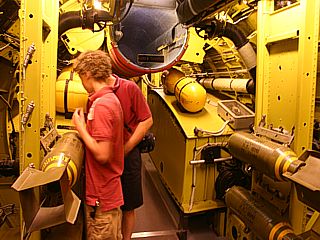
|
This is the interior of a section of a B-29 bomber on display at the US Air Force Museum near Dayton, Ohio. The unique feature is that there was a small "tunnel" that passed from the rear pressure bulkhead to the tail section (another area where crew usually slept) of the aircraft over the unpressurized bomb-bay compartment. A section of that tunnel can be seein along the top of this picture. The rear pressure bulkhead looks like an "umbrella" tilted on its side, is the rear-most "wall" in this picture. Note the bomb racks, oxygen tanks, and limited space in the bomb-bay. The downward-opening doors to the bomb-bay are below (and part-of) the floor of the aircraft. |
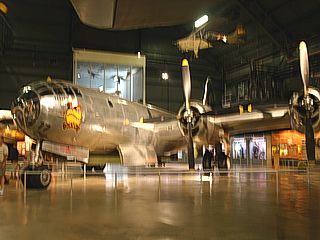
|
Here is one of the B-29 "Superfortress" aircraft that ended World War II with the release of the "Fat Man" atomic bomb over Nagasaki, Japan. This B-29, called "Bockscar", is on display at the US Air Force Museum near Dayton, Ohio. It's hard to comprehend how such gruesome war-history, almost close enough to touch, can be imagined while walking under the silver belly of this aircraft ... Most likely brightly illuminated by the heat and light of a Japanese city and its occupants vaporizing miles below it. |
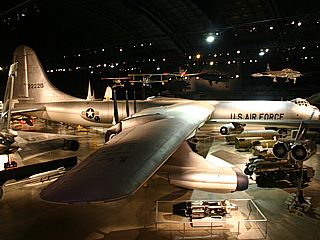
|
This is a very interesting and strange heavy bomber aircraft. This is the Convair B-36 "Peacemaker" aircraft on display at the US Air Force Museum near Dayton, Ohio. If you take a close look at this large aircraft, you see three pusher-propeller engines at the rear of the wing making a total of six propeller-driven engines. But if you look forward of the wings, there are two jet engines in a twin-podded nacelle as well, making for a total of four turbojets. The propellers were driven by six Pratt and Whitney "Wasp Major" radial engines at 3,800 HP each. The turbojets were General Electric J-47 engines rated at about 5,200 pounds of thrust each. The jet engines allowed much shorter take-off roles for this aircraft, as well as brief "dashes" of speed if needed, as much as 420-MPH. Cruising speed (jets off) was 230-MPH. The plane featured a range up to 10,000 miles and a 48,000 foot service ceiling. Also, look to the far right in this picture. You can see the wing of a nearby B-47 "Stratojet" as well! |
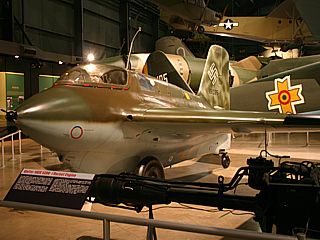
|
This is a German Messerschmitt ME-163 "Komet" on display at the US Air Force Museum near Dayton, Ohio. This was a very interesting and unique aircraft, and was the only operational rocket-powered fighter plane during World-War II. As a product of Hitler's vengant Luftwaffe, the plane was primarily used to rapidly climb to altitudes of overflying bomber aircraft, attack them, then glide back down to earth. A Walter 109-509A-2 rocket engine, also shown in the foreground of this picture, produced nearly 4,000 pounds of thrust using liquid fuels C-Stoff (methanol and hydrazine) and T-Stoff (concentrated hydrogen peroxide), both extremely toxic and dangerous, the latter capeable of igniting organic material (including flesh) on contact. The plane ignited this rocket, which burned for no more than a few minutes. In this time, the aircraft would do a short takeoff roll, on releasable dolly-wheels, then zoom-climb to over 30,000 feet reaching speeds approaching 600-MPH. The aircraft would zoom past the bombers, attempting to shoot at them in that short timespan. After burnout, the plane would glide back down and land on its hardened belly-skid. Note the RAT (Ram-Air Turbine) in the nose of the aircraft, which is a small propeller that turned in the wind-stream to generate electrical power. |
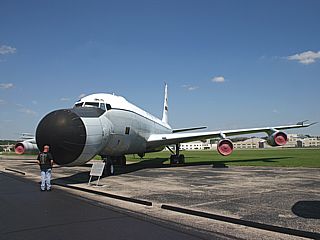
|
This is a EC-135 on display on the outside near the main entrance of the US Air Force Museum near Dayton, Ohio. This is basically a re-engined and modified version of a Boeing 707 (the Military version is called a C-135). The one on display here is called the "Bird of Prey" and it's exceptionally large antenna system in it's nose is housed by a huge radome giving the plane a nickname "snoopy". The plane was used as an Advanced Range Instrumentation Aircraft (ARIA), allowing communication links between satellites and the Apollo spacecraft. |
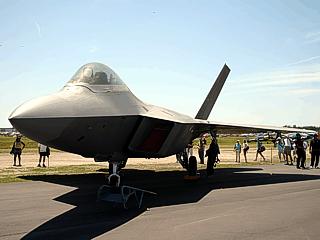
|
This is an F-22 "Raptor" fighter on display along the active flightline at the 2006 Sun n' Fun airshow in Lakeland, Florida. The aircraft does not look like much from the front, no wing mounted pods, smooth surfaces, and sponson-chined front. Once in the air, this aircraft is like no other, capable of reaching supersonic speeds with or without afterburners, climb to the edge of space in about a minute, and perform nearly surrealistic meneuvers (many of which still classified as of 2006). Bombs and missiles are not stored under the wings, but in compartments in the aircrafts lower sides. A low radar profile of this plane also makes it appear like a small bird on enemy radar. The F22 is intended to be the air superiority fighter well into the 21 century. Look closely to the lower-right and you will see two marshalls standing guard with MK-17 rifles. |
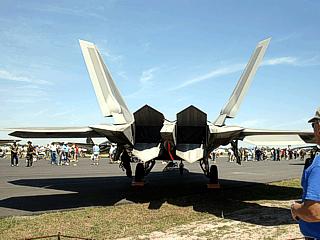
|
Here is another picture of the F-22 "Raptor" fighter on display along the active flightline at the 2006 Sun n' Fun airshow in Lakeland, Florida. The rear view shows the two angled tail planes and, most importantly, the nozzles of the two massive 30,000+ thrust F119 (Pratt and Whitney) engines. The rectangular jet exhaust nozzles and thrust-vectoring vanes (in their wide-open positions) can be seen. it is this nozzle and engine configuration that enabled the F22 to perform such incredible meneuvers, such as "hovering" with an extreme nose-high attitude using only engine thrust to stay aloft. As of 2006, not that many people have seen this new fighter at airshows. |
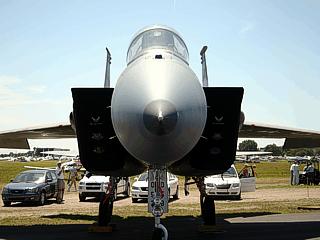
|
This is a picture of the F-15 "Strike Eagle" fighter on display along the active flightline at the 2006 Sun n' Fun airshow in Lakeland, Florida. The front view of this plane shows its massive nose-cone radome, top cockpit canopy, and jet intake ducts on each side. The F15 is a fixed wing fighter also designed for air superiority, and is powered by two F119 engines (Pratt and Whitney) each producing at least 25,000 pounds of thrust. Much like the F22, and producing far more thrust than the aircraft's weight, the F15 can also break the sound barrier going straight up. |
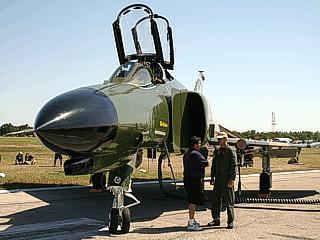
|
This is an F-4 "Phantom" fighter on display along the active flightline at the 2005 Sun n' Fun airshow in Lakeland, Florida. The pilot (standing to the right with the baseball cap) is being interviewed by a local news crew in the foreground. |
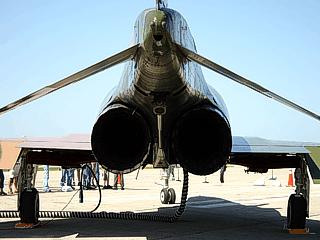
|
Here is another picture showing the rear-end of an F-4 "Phantom" fighter jet. This F-4 was on static display at the 2005 Sun n' Fun airshow in Lakeland, Florida. Note the precarious nozzles of the two afterburning engines! The engines are most likely General Electric J79 afterburning turbojets (although some F4's may use Rolls Royce "Spey" engines). Also notable is the "inverted-V" stabilators / elevators of the tail, exclusive to the F-4. |
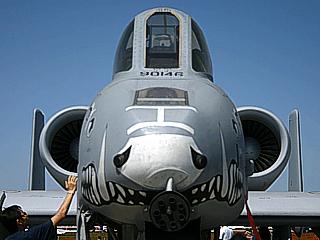
|
Here is a picture of an A-10 "Warthog" attack aircraft as viewed from the front. Note two things ... First, the two huge rear-mounted turbofan jet engines, second, and most importantly, the huge gun (the plane is actually built around this huge gun system) under the nose of the plane (something an enemy will remember even after he is killed)! This was at the 2005 Sun n' Fun airshow in Lakeland, Florida. |
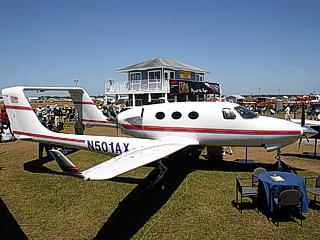
|
This is an Adam A-500 aircraft at Sun n' Fun 2005 in Lakeland, Florida. It is a twin engine axial (one in the front, the other in the back) design and also has a jet version (with the SAME airframe) in the A-700 model. Turboprops power the A-500 while two Williams J33 engines power the A-700. This is all-new composite / exotic aircraft design that is the brain child of Burt Rutan (Scaled Composites) who set numerous speed, altitude, and endurance records including the X-Prize. |
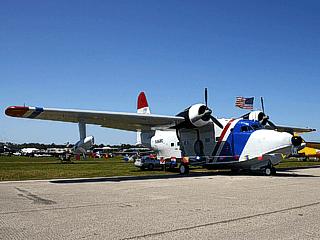
|
A Grumman SA-16 "Albatross" sits on the edge of the closed runway at Lakeland Airport for the 2005 Sun n' Fun airshow. This was a large high-wing amphibian (sea-plane AND ability to land on its wheels) and one of many still flying today (Chalk's airlines out of Miami flies Grumman Albatrosses to and from the Bahamas). |
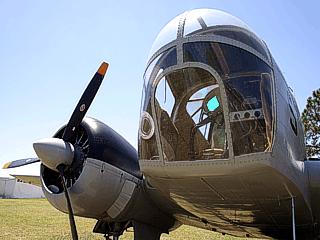
|
This is the nose-gunner pod of a restored AT-11 vintage WW-II bomber-trainer aircraft (similarly based on a Beech 18), which is also similar to the B-25 "Mitchell" aircraft. This AT-11 aircraft in its day was a WW-II bomber but had armament as you see here for self-defense. This aircraft was on display for the 2005 Sun n' Fun airshow in Lakeland, FL. |
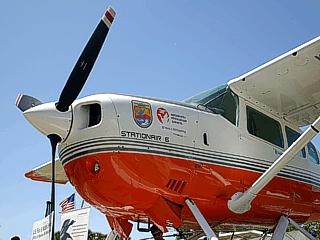
|
Here is a picture of the nose and front of a Cessna 206 amphibious (sea-plane) model at the 2005 Sun n' Fun airshow in Lakeland, FL. The Cessna 206 can hold about 6 people and comes in a tricycle (3 wheel) and seaplane versions (shown here). |
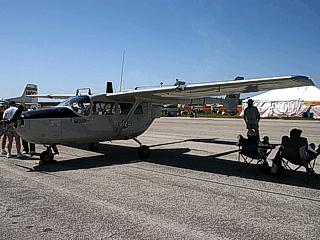
|
This is a Cessna-337, the same type of airplane you might have seen flying off Cuba from Miami's "Brothers to the Rescue". This plane, on display at thew 2005 Sun n' Fun fly-in in Lakeland, FL, has 2 engines, one in the front and the other in the back (twin-axial). The civilian version of this plane is called the "Sky Master", and the military version is an O-2. |
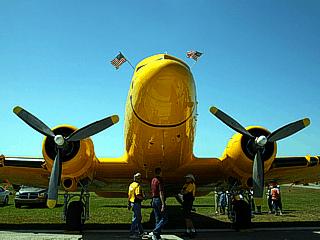
|
This is a Douglas DC-3 (or C-47 for military / cargo designation) viewed from the front at Lakeland Airport, Florida during the 2005 Sun n' Fun airshow. Two huge Pratt and Whitney "Wasp" radial piston engines power this vintage tail-dragger airliner. Many still fly today, especially in the third world. |
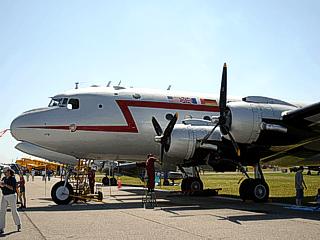
|
A big step up from the Douglas DC-3 is the DC-4 shown here on static display at Lakeland Airport's Sun n' Fun 2005. This plane has four Pratt and Whitney "Wasp" radial piston engines and "tricycle" type landing gear. It is also designated as the C54 for its military / cargo versions. |
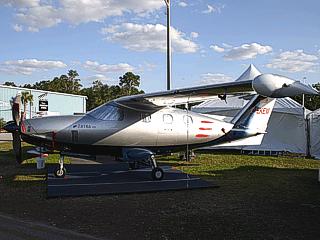
|
Extra aircraft of Germany is widely known for its high performance, cutting-edge aerobatic aircraft, such as the Extra 200 and 300. But here, we see a sleek Extra 500 private general aviation aircraft on display at Sun n' Fun 2005 in Lakeland, FL. This version is similar to the Extra 400, and employs composites and light weight space-age materials in its beautiful airframe. |
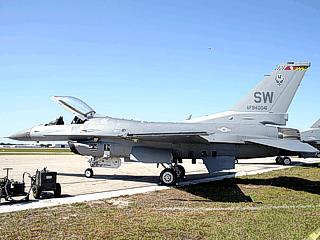
|
An F-16 "Fighting Falcon" rests on the active flightline just minutes before tearing up the sky in a demonstration flight over Lakeland, FL at Sun n' Fun 2005. It is pretty adventurous to even get close to one of these things. Later, the grass to the right of the plane in this picture was burned as the engine started up! |
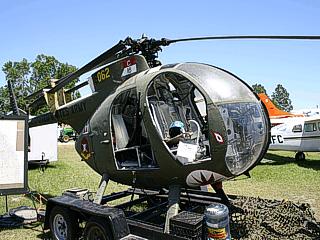
|
This is a Hughes 500 (or Mcdonnel Douglas MD-500) series helicopter near the US Army post at the 2005 Sun n' Fun airshow in Lakeland, FL. This light helicopter is popular for scouting operations and can even be trailered as shown here. Also note the camoflage lying in front of the nose. It is a versatile gas-turbine powered helicopter that has a wide use in both civilian and military aviation. |
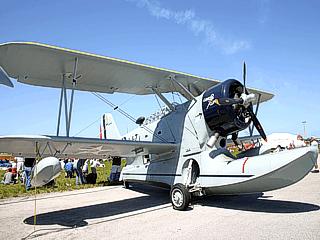
|
Here is a picture of an amphibious (land and sea-plane) Grumman J2F "Duck" aircraft at Lakeland's Sun n' Fun airshow in Florida in 2005. This large plane can hold ample cargo in its lower portion while its two-wings (bi-plane) gets it in the air quickly. Note that there is the canopy for the pilot(s) plus passenger areas under that in the center of the plane fusalage. |
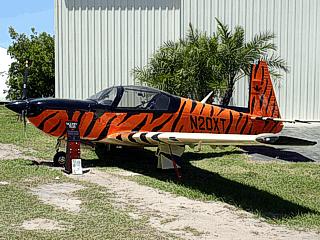
|
This is a picture of a small kit plane, a Mooney Tiger model, in front of the Florida Air Museum at 2005 Sun n' Fun in Lakeland, FL. |
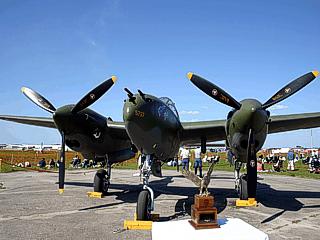
|
This is "Glacier Girl", a P-38 "Lightning" with a long story leading up to its restoration to airworthiness. This plane was lost near Greenland and later buried in over 200 feet of ice under a glacier. Many years later, the plane was located and brought back to the surface in a daunting salvage operation. The plane was completely restored, and flies again at the Sun n' Fun airshow in Lakeland, FL! Note the "Phoenix" trophy in the foreground representing "rising from ashes". |
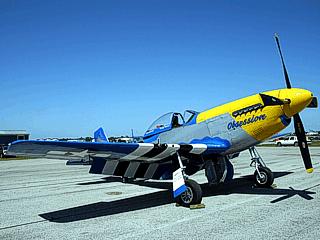
|
Here is a static display of a P-51 "Mustang" along the active flightline at Lakeland Airport for Sun n' Fun 2005 in Lakeland, FL. This plane's owner dubbed it with the name "Obsession". |
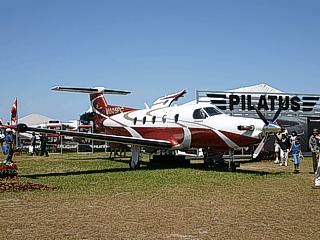
|
This is a Pilatus PC-12 cargo and / or passenger aircraft at Sun n' Fun 2005 in Lakeland, FL. This Swiss-built plane was introduced in the mid 1990's as an efficient, reliable, and versatile UTILITY aircraft (kind of like an SUV, but in a plane). This plane can quickly be changed to accomodate all-cargo, all-passenger, or "combi" (cargo AND passengers). |
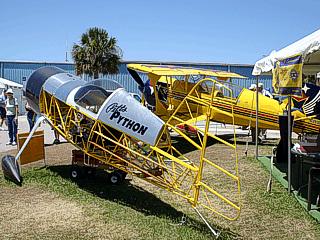
|
In this picture, Kimball Enterprises aircraft displays two kit versions of their successful "Pitts" line of aircraft (such as the Pitts Special) at Sun n' Fun 2005 in Lakeland, FL. A half-completed Pitts "Python" (a prototype to fly later in 2005) is in the foreground and a Pitts "Model-12" (with engine cowl doors removed) is behind it. |
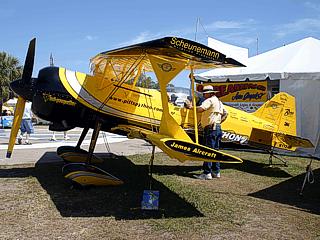
|
Here is another picture, taken a year later in 2006 at Lakeland, FL at Sun n' Fun, with a completed version of the Pitts "Python". This Pitts "Python" is completed and ready to fly, and is very similar to the one under construction in the picture above. The builder did a fantastic job at this unique version of the successful Pitts biplane. |
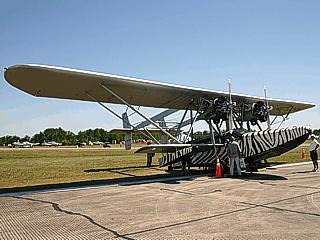
|
Another amphibious aircraft can be seen here at 2005 Sun n' Fun in Lakeland, FL (remember, "amphibious" means land AND water capable). This restored aircraft is called "Osa's Ark", and is an S-38, greatly influenced by the Russian Sikorsky (who's company, based in the United States, built sea planes before helicopters). Note that this plane is a biplane, but the lower "stub" wings are shorter. Also note the completely exposed twin-radial engines. |
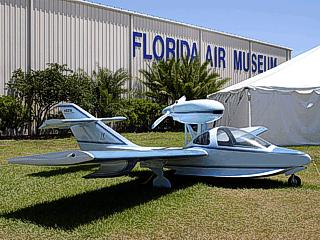
|
This picture shows an amphibious kit-plane on display at 2005 Sun n' Fun in Lakeland, FL in front of the Florida Air Museum. Most sea-planes and amphibians (land AND sea) have high mounted engine compartments to avoid water / salt damage to the engine(s). The rather exotic small amphibian shown here only hold one pilot. |
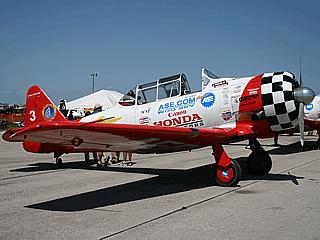
|
This is a picture of a T-6 "Texan" aircraft along the active flightline just prior to performing at the 2005 Sun n' Fun airshow in Lakeland, FL. This is one of 4 T-6 Texans used by the precision aerobatic team "Aeroshell". |
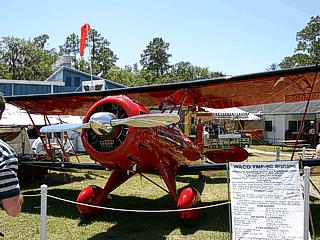
|
Here is a vintage WACO biplane on display at 2005 Sun n' Fun in Lakeland, FL. Here the aircraft is beautifully restored as if it was (and it is) a flying antique. Many are still flying today. This aircraft can take you back to an open-cockpit WW-I experience. |
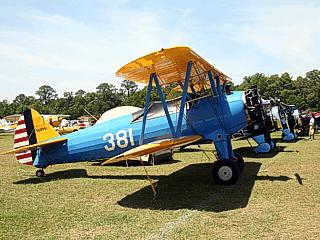
|
Here is a line-up of vintage Stearman biplanes on display at 2006 Sun n' Fun in Lakeland, FL. |
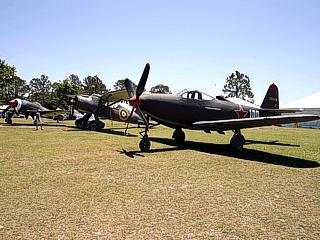
|
Various classic "war birds" line up for static display near the Florida Air Museum for Sun n' Fun 2005 in Lakeland, FL. |
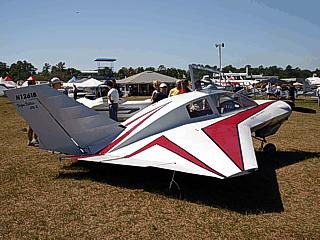
|
Here is a picture of one of many "kit" planes on display at the Sun n' Fun 2006 event in Lakeland, FL. This kit plane, called a JD-2, was put together by a home builder and even sports "jet fighter" style delta wings. It is a propeller driven aircraft and like all other home builts, needs to pass FAA inspections, have a "check-out" by a test pilot, and finally receive and air-worthiness certifcate before a builder pilot can fly it. |
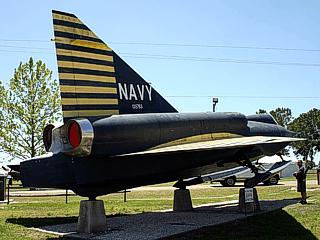
|
This is a Convair XF2Y-1 "Sea Dart" on permanent display at the Florida Air Museum in Lakeland, FL. This picture was taken during the 2005 Sun n' Fun airshow. The plane here is similar to an F-7, but beleive it or not, is a sea-plane! It is the fastest sea-plane ever built, and took off water at over 110 Knots. Once in the air, the skids were retracted and supersonic speeds were attainable. The plane was experimental. |
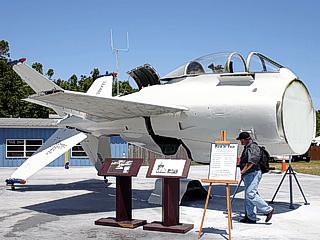
|
Even stranger still is the Lockheed XFV-1 "Salmon" aircraft, which preceded the "Pogo" versions of VERTICAL TAKEOFF aircraft. The plane is shown here on display at the Florida Air Museum in Lakeland, FL during 2005 Sun n' Fun. Just the airframe appears here, laying on its side, less the massive engine (nearly 40 percent of this aircraft's weight was from its engine alone) and counter-rotating propellers in its nose. The airplane normally stood on its tail, took-off straight up, then transitioned to and from horizontal flight in the air. The strange experimental plane could climb at over 11,000 feet per minute (thats a vertical speed of over 130 MPH from near sea level) and had a ceiling of over 41,000 feet. |
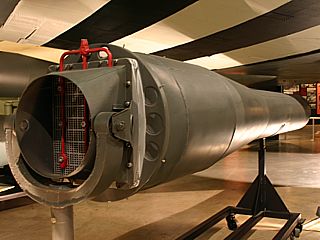
|
Here is a picture of an Argus Pulsejet engine that powered the infamous German V-1 "Buzz Bomb". The engine is on display in Dayton, Ohio at the US Air Force Museum. In this picture, the front of the engine with the vane-type valve inlet assembly can be seen. This was the only moving part(s) on this engine, but the most important. When the inlet closes, fuel is injected into the body of the engine where it burns (either spark ignited, or from heat in a well "warmed-up" engine) producing an exhaust out the rear tail-pipe and forward thrust (reaction). The front valve then opened, allowing a fresh charge of air to enter, and closed again to repeat the fuel mix and combustion process again. This process, ocurring many times a second, was extremely noisy. Such an engine also was called the "studdering stovepipe" and became nearly white hot when operating. It also consumed tremendous amounts of fuel, and was best for speeds no more than 300-MPH and operated best at low altitudes. These characteristics made the pulsejet most practical to propel a short-range weapon, such as the German V-1 bomb. |
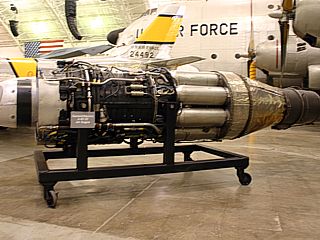
|
This is an early (late 1940's) General Electric J-47 (GE-25) turbojet engine on display at the US Air Force Museum near Dayton, Ohio. The engine was one of the first successful (and reliable) jet engines and produced about 5,670 pounds of thrust. Note the long tail-pipe and combustor "burner-cans" just ahead of the tail pipe. The F-86 fighter was powered by this engine, and used it to break a world speed record of over 670 MPH back in 1948 for early jet aircraft. |
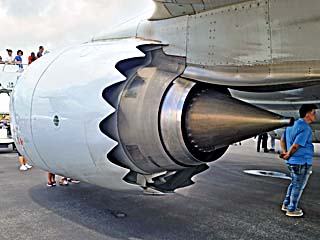
|
This is a new CFM International LEAP ("Leading Edge Aviation Propulsion") high-bypass turbofan engine on a Boeing 737-MAX aircraft (American Airlines) that was on static display at the Wings over Homestead airshow in early April 2023. The "chevrons" mix the air into the bypass duct and core-flow to reduce noise. The little tube and outlet in the tail-cone of the core-flow (by the man's neck) is a vent for the rear bearings and cooling air. These engines produce roughly 30,000 pounds (~135 KN) of thrust. |
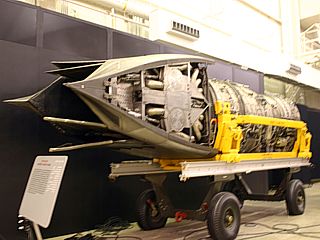
|
Over fifty years of aviation technology separates the last picture above of the GE J-47 engine and this one, the mighty PW-100-229 afterburning turbofan engine, also on display at the US Air Force Museum near Dayton, Ohio. This engine variant powers the F-22 "Raptor" aircraft, and the most striking feature in this picture is the nozzle assembly. Unlike the "turkey-fin" nozzle control system on many fighter aircraft, this nozzle uses flaps to not only constrain the exhaust stream of the jet, but also aim it up and down to provide vectored-thrust. This is how planes like the F-22 can perform seemingly "impossible" meneuvers. The engine, with afterburner, produces about 29,160 pounds of thrust ... The F-22 has two of these engines! |
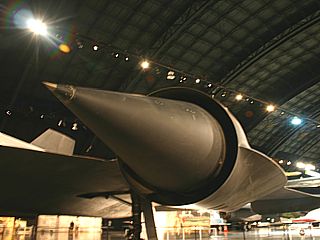
|
This is the engine inlet, with a large cone called an "aerospike", of an SR-71 "Blackbird" aircraft at the US Air Force Museum near Dayton, Ohio. The inlet cone is the most important part of the engine nacelles housing each of the two Pratt and Whitney J58 afterburning hybrid turbojets. The J58 is a hybrid engine, meaning that it functions as a turbojet during subsonic and low supersonic flight, but also behaves more like a ramjet at high-supersonic speeds (2,000 MPH+) and very high altitudes (over 75,000 feet). The inlet cone is moveable (variable geometry) and it's goal is to slow-down the high-speed air BEFORE reaching the actual inlet of the J58 compressor. At very high speeds, air is simply routed around most the engine and into the afterburner, providing more of a ramjet function (excess air can also be "dumped" as well). Aiming the shock-wave properly by precisely moving the cone accomplishes the proper conditions to allow the engine to perform in a variety of high speeds / high altitudes. The engine, with afterburner, produces 32,500 pounds of thrust. |
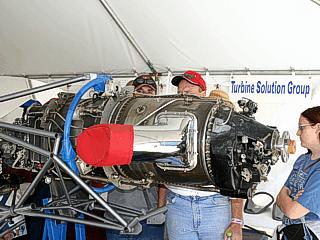
|
This is a picture of a demonstration of a gas turbine engine, similar to a PT6 series engine, on display at the 2005 Sun n' Fun airshow in Lakeland, Florida. |
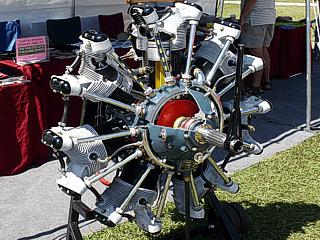
|
Going back in time and power to an earlier era, this is a picture of a Jacobs R-755 radial engine cut-away (non-working demo) on display at Sun n' Fun in Lakeland, FL in April 2006. This engine is a 7-cylinder radial engine and is very similar to the 9-Cylinder Pratt and Whitney "Wasp junior". Used to power (or re-power) many vintage aircraft, it weighs just over 500 pounds (dry weight) and develops about 350 HP at the output shaft. |
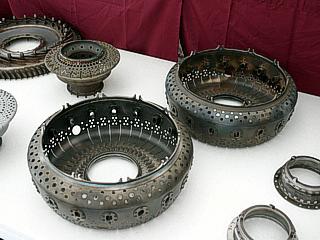
|
Here is a picture of "toroidal combustors" at the 2005 Sun n' Fun airshow in Lakeland, Florida. These special combustion chambers are where the fuel and air burn inside a gas turbine engine's "hot section". |
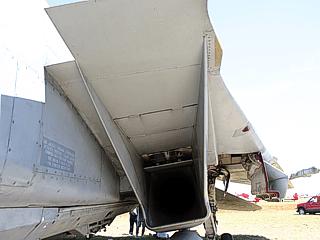
|
This is the engine inlet of an F-14 on static display at the 2006 Sun n' Fun airshow in Lakeland, Florida. This inlet is very important because it has moveble "ramps" and is shaped in such a way to allow a wide range of airspeeds, and altitudes, from landing near sea level to high supersonic speeds in the stratosphere. The goal of such a VARIABLE GEOMETRY inlet is to slow down supersonic airflow and limit (or permit) airflow to the engine itself to avoid "compressor stall" so the engine can run reliably at all airspeeds. For example, at high altitude at speeds less than the speed of sound the inlet allows as much air as possible to the engine. At low altitudes, in much dense air, some air is diverted to the engine, while much is simply routed past it (dumping air). At supersonic speeds, the inlet slows the air to go into the engine to subsonic speeds (excess air is "dumped") by aiming shock waves accordingly (via the positions of the moveable "ramps") and is dependant on altitude. A computer controls most of this activity. many supersonic aircraft, including the Concorde, had variable-geometry jet intakes. |
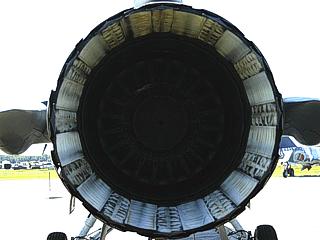
|
This is the "business end" of an F-16 fighter jet! In this picture, the view is looking into the tail-pipe and afterburner nozzle (note the "turkey-fins") of a Pratt and Whitney F-100 series jet engine. This F-16 was on static display at the 2005 Sun n' Fun airshow in Lakeland, Florida. Note the afterburner "flame holder" rings inside the burner can! |
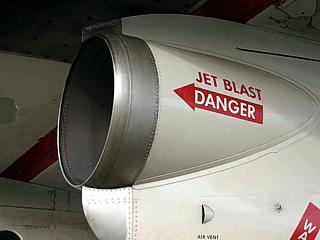
|
Here is a picture of the exhaust pipe of the engine of an E-2C "Hawkeye" aircraft on static display at the 2005 Sun n' Fun airshow in Lakeland, FL. Ominous warnings such as "Jet Blast Danger" appear on many military aircraft to warn personnel working around these planes. In some cases, turbine jet blast can be an extremely dangerous situation. It is hot (often with an EGT of over 500 degrees Celsius), and sometimes extremely fast (up to supersonic speeds), and can start fires and / or damage or destroy property. Jet blast from a military jet can hurl a person (who is unlucky enough to get in its path) across an entire aircraft carrier deck! |
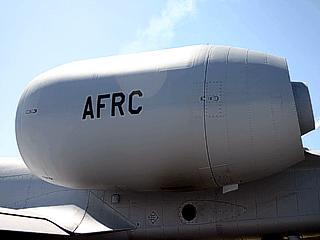
|
Any idea what aircraft this jet engine nacelle belongs to? If you guessed "A-10", you are right! The A-10 was on static display at the 2005 Sun n' Fun airshow in Lakeland, FL. The engines are General Electric TF-34's, each producing over 9,000 LBS of thrust. You can actually walk up and touch these planes. |
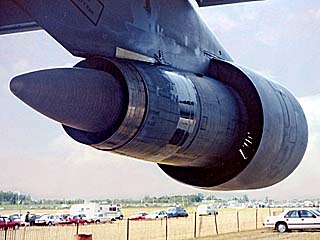
|
This is the engine nacelle of a C-5 "Galaxy" aircraft on display at the Miami (Florida) air show in 1991. This nacelle houses a General Electric TF-39 engine, a predecessor to the popular CF-6 engine used in airliners, and produces over 43,000 pounds of thrust. |
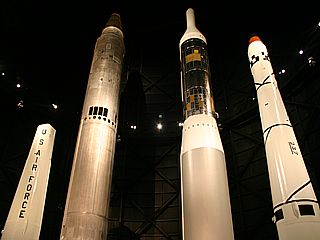
|
Four Inter-Continental Ballistic Missiles (or ICBM's) stand tall in the space gallery center at the US Air Force Museum near Dayton, Ohio. From left to right is a Douglas SM-75/PGM-17A Thor, a Convair SM-65 Atlas rocket, a Boeing LGM-30B Minuteman I, and a Martin Marietta SM-68B/LGM-25C Titan II. |
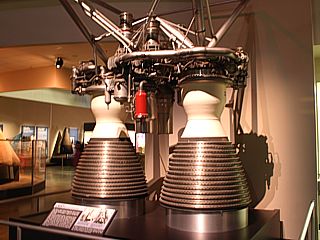
|
This is an Aerojet LR-87 engine system on display at the US Air Force Museum near Dayton, Ohio. The LR-87 engine system is a liquid-fuel (hypergolic fuels Hydrazine / Aerozine and Nitrogen Textroxide preferred) twin-rocket engine capable of about 500,000 pounds of thrust on average. It is the engine of choice on most Titan class rockets (including the ICBM missiles). |
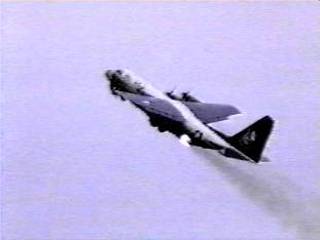
|
In this picture, taken at the Miami Airshow at Homestead Air Reserve Base, Florida in November 1994, a C-130, dubbed "Fat Albert" executes a JATO (Jet Assisted Take Off) using JATO rocket bottles. The small rockets provide about 8,000 pounds of thrust and allow the heavy C-130 Hercules to take off under heavy weight loads and / or short airstrips. In this picture, "Fat Albert", the supply aircraft for the Blue Angels, with an empty cargo bay can climb at a 45 degree nose-up attitude to 1,500 feet in seconds! Note the bright flames and smoke from the rockets, which burnout after about 20 seconds. |
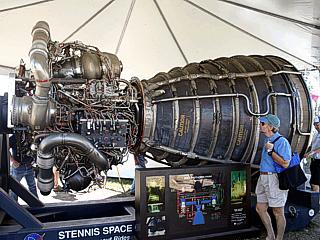
|
This is an actual space shuttle main engine on display at Sun n' Fun in Lakeland, FL in April 2006. This is a rocket engine, capable of over a half a million pounds of thrust, and uses liquid oxygen and liquid hydrogen fuel. The cryogenic liquid fuel is fed by two 29,000 horsepower turbopumps (one can be seen at the top left part of the unit) which reacts in a chamber at the base of the bell-shaped nozzle. The reaction products (steam) leave the nozzle at about 6,000 MPH and the resistance of change in momentum (due to Newton's law) produces a recoil effect (for every action, theres and equal and opposite reaction) that pushes the engine (and spacecraft attached to it) forward. Liquid hydrogen, at about -420 degrees, cools the nozzle bell via small tubes of Monel metal (NI-MO alloy) that line it to prevent it from melting (and also pre-heating the fuel). |
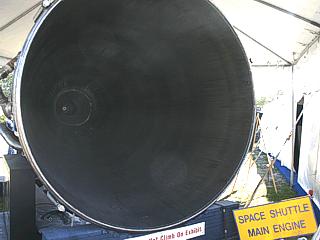
|
Here is a view of the nozzle bell end of the space shuttle main engine on display at Sun n' Fun in Lakeland, FL in April 2006. Looking closely at the inner surface of the "walls" of the nozzle bell, you can make out the hundreds of tubes that cool the nozzle and pre-heat the liquid hydrogen fuel. At the center of the nozzle (near its base) is the actual chamber where the hydrogen and oxygen combine and react. This bell-shaped nozzle common in rocketry is sometimes called a "divergent nozzle". |
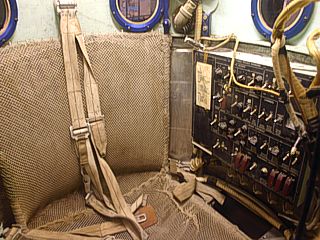
|
This is the interior of the hermetically-sealed pressure capsule (gondola) used on the Project "Manhigh" in the 1950's. These were balloon experients to validate the effects of high-altitude cosmic rays on humans. The three flights were conducted by the US Military and one of them went to heights exceeding 101,000 feet. In this picture, the gondola that carried Major David Simons to 101,560 feet on Manhigh II is shown here from it's cramped interior through a small portal. |
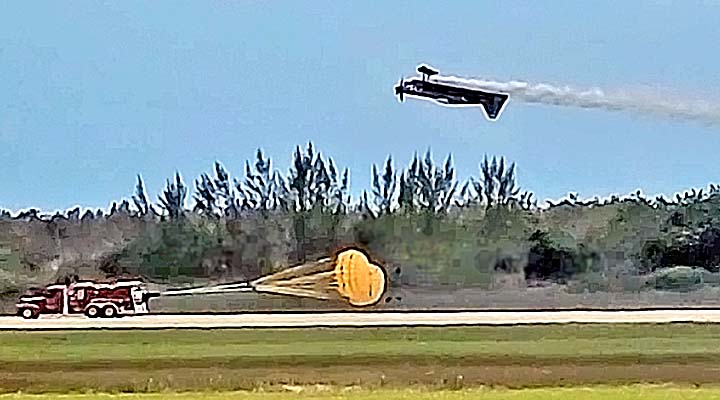
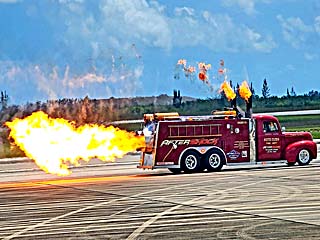
|
This is the "AfterShock" fire-truck at the Wings over Homestead airshow in Homestead, Florida in April 2023. The truck is a highly modified 1940 Ford Fire-truck with two Rolls Royce Viper afterburning turbojet engines capable of generating 24,000 equivalent horsepower. The truck holds a world speed record of 407-MPH. In this picture, the fire-truck is performing its run-up and fire-show, producing bright yellow flames, noise, and lots of heat. |
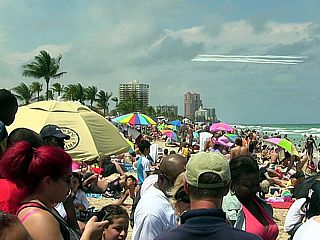
|
Here is the crowd at the 2013 Fort Lauderdale Air and Sea Show in April 2013. Not as big as the crowds from the early 2000's, but certainly a good turnout. |
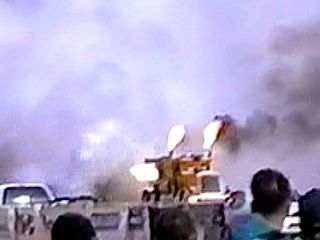
|
This is Les Shockley's "Shockwave" truck at the Miami Airshow in Homestead, Florida in November 1994. The truck is a highly modified Peterbuilt semi-truck with three Pratt & Whitney J-34 afterburning turbojet engines capable of generating over 19,000 pounds of thrust (36,000 Horsepower). The truck holds a world speed record of 374-MPH, and can reach 300-MPH in only 11 seconds. In this picture, the engines are "spooling" (revving) up and a stroke to the afterburner lever with the engine at low power settings produces bright yellow flames and lots of smoke. Unfortunately this amazing vehicle was destroyed during a high-speed run back in July of 2022 (near Battle Creek, Michigan), killing the driver, Chris Darnell. |
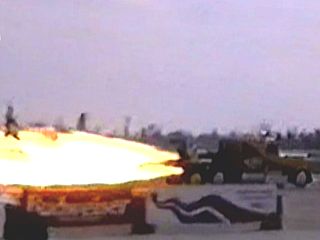
|
Here is another view of the "Shockwave" truck at the 1994 Miami Airshow in Homestead, Florida. The truck is preparing to accelerate to about 300-MPH and catches up with a 200-MPH airplane and passes it as the crowd awes at the sheer power of this vehicle. In this picture, hot yellow fire shoots out of the tailpipes of the three J-34 engines. |
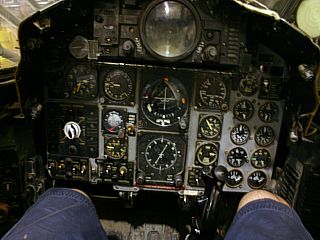
|
Here is myself sitting in a section of the cockpit of an F-4 "Phantom" at the US Air Force Museum near Dayton, Ohio. The cramped cockpit contains hundreds of switches and dials in addition to the basic flight controls and displays (such as the radar scope and attitude indicator). This is a far-cry from the "glass cockpits" of modern day fighters. |
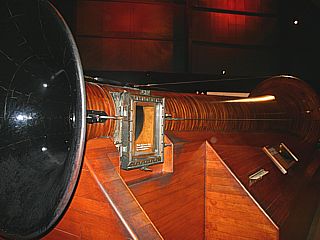
|
This is a picture of an early wind-tunnel on display at the US Air Force Museum near Dayton, Ohio. You are looking at the intake side of the tunnel, with a large "trumpet-shaped" air intake plenum in the front. The view is from the front towards the rear. The fan driving the wind-tunnel is in the rear of the structure, behind the "coke bottle" shaped region. The test section is just behind the intake duct (the small window). This tunnel, although a work-of-art made nearly entirely of wood, had a wind-speed of over 430-MPH. |
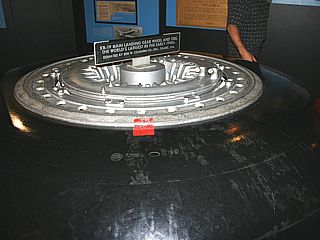
|
This is a large aircraft wheel and tire assembly, one of the largest during it's time in thr 1940's, from an XB-19 aircraft. It is on display at the US Air Force Museum near Dayton, Ohio. Note the size of the person standing next to the wheel. |
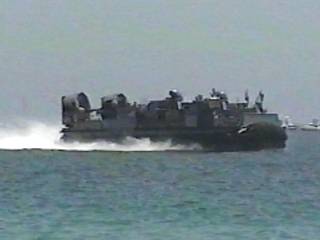
|
During the Fort Lauderdale Air and Sea Show in May 1996, a US Navy LC hover-craft makes a high-speed pass off Fort Lauderdale beach at over 65 MPH. The LC is designed to carry troops, supplies, land-vehicles, and even tanks across water then onto land in what is called an "amphibious assault". |
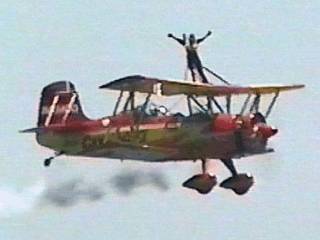
|
This is a picture of the Wing-Walking demonstration at the Fort Lauderdale Air and Sea Show in May 1996. The plane here is a highly modified Grumman Ag-Cat, which began as an agricultural plane (aka "crop duster"). The plane was re-designed, engine-power upped, wings clipped, and most of all, the hopper and crop-dusting equipment removed. What was left was a fully aerobatic and large bi-plane in which a daring team member can ride in a special "seat" atop the middle of the top wing. Often, the wing-walker detaches from this seat and moves around the plane, hanging on to wing struts, dangling from landing gear, etc, hence the name "wing walking". This plane also has a distict "supersonic clatter", where the propeller blade tips make a loud buzz because they near the speed of sound ... Truly an airshow spectator's delight. Did you know? The pilot of this aircraft nearly succombed to kidney disease and because he recieved a kidney donation from his wing-walking companion, he still flies today! |
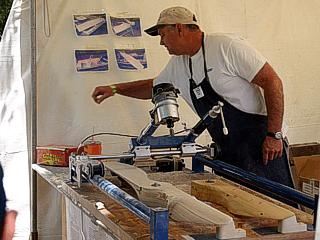
|
Here is a picture of an aircraft mechanic demonstrating a special lathe to manufacture a fully-functional aircraft propeller out of wood in under two hours. Demonstrations of special tooling like this were common at the 2005 Sun n' Fun airshow in Lakeland, Florida. |
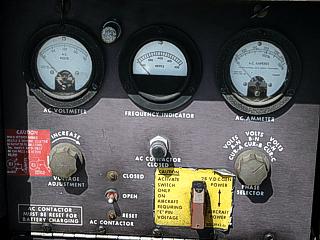
|
This is the control panel for a military aircraft ground power unit (or GPU). This is simply a 400-Hz AC generator for aircraft power while the plane is sitting on the ground (the plane is "plugged into" it). |
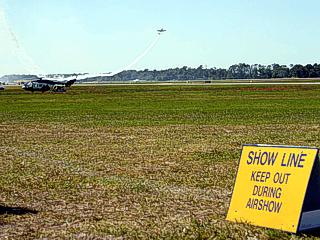
|
This is a view from a remote edge of the flightline during the 2005 Sun n' Fun airshow in Lakeland, Florida. This was an interesting place to view the show as there was virtually no crowd there. Note the "warning" sign at the edge of the flightline to the right while an airshow performer is pulling up from a low approach with smoke on to the far left. |
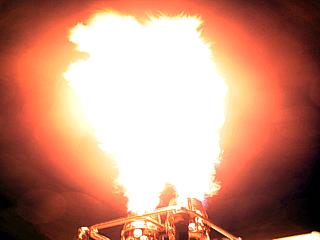
|
A hot air balloonist fires up his propane burner in anticipation for the 2006 hot air balloon races at Sun n' Fun 2006 in Lakeland, FL. The super bright flame, normally precariously inside the fabric balloon envelope, lights up the entire night sky. Don't get too close, it would singe the hair on your face! |
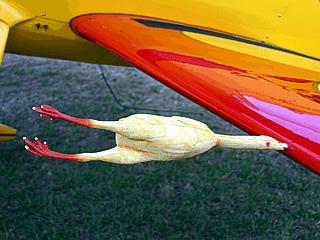
|
Not sure about this one ... Looks like a pilot put a rubber chicken over a pitot tube instead of the standard red "remove before flight" ribbons! |
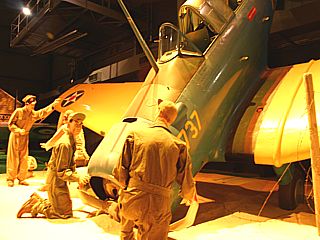
|
A mock-up of a minor plane crash is displayed in stark reality at the US Air Force Museum near Dayton, Ohio. In this picture a "trainer crash diarama" depicts a cadet who flipped his aircraft by braking too hard, and having a tailwind lift the plane up and causing it to nose-over into a fence. The seargent is giving him a stern lecture (left) as the aircraft mechanics survey the damage (center). A serious incident, but humerous to watch. |
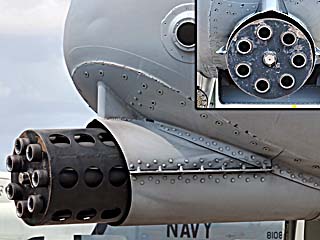
|
The A-10 was basically built around a huge Gatling gun - A high power 30mm GAU-8 Avenger rotary autocannon. This can discharge a staggering 3,900 rounds per minute, traveling at up to 3,324 feet-per-second, and is accurate to at least 4,000 feet downrange. This canon is so powerful that it needed to be mounted off-centre (to the port side) of the fuselage so the massive recoil of it won't knock the plane off course (this 10,000 pounds of recoil alone was more than the thrust of each of the A-10 engines)! |
HTML File "airshow.htm" - Developed By Chris Collura
To Return To The HOME Page Of This Site Click The "INDEX.HTM" Link Here!